1lumen selects and reviews products personally. We may earn affiliate commissions through our links, which help support our testing.
Nightwatch NS14 review

Nightwatch NS14 specs
| Brand & Model | Nightwatch NS14 |
|---|---|
| Flashlight category | Lumenmonster |
| LED | 14x SFQ55.4 |
| Max. output | 43,000 lumens |
| Max. beam distance | 748 meters |
| Max. beam intensity | 140,000 cd |
| Battery config. | 2×21700 |
| Onboard charging | None |
| Modes | 5 |
| Blinkies | Strobe |
| Waterproof | IPX6 |
| Review publication date | May 2023 |
Review intro:
In May 2022 a pretty special flashlight came across my desk for review. It was from a company I was somewhat familiar with already, but one that still didn’t have much exposure to Westerners or those outside of China. This makes sense because they’re mostly sold on Taobao, which for all intents and purposes is a Chinese version of Banggood or Aliexpress. However, they’re also sold by every flashlight fan’s favorite merchant, Nealsgadgets.
Neal can get enthusiasts the lights otherwise not available outside Taobao, and I’ve sampled a few thus far. These are all made by Nightwatch, and these are some of the most crazy flashlights I’ve ever sampled. They’re affordable, fairly well-made, and very utilitarian. They also make big performance claims, where by ‘big’ I mean a bit ludicrous. One such light is the NS59v1. Unofficially known as the Chaos, it was every bit as chaotic as it promised. Nightwatch released a second NS59v2 with some upgraded LEDs and design changes in late 2022, and now there’s a new one dubbed the NS14.
How do you make a bonkers light even more bonkers? Add LEDs…a lot more, like 5 more, direct-drive them with a couple of 21700s in series, and stick everything in a sub-400 gram host.
The first NS59v1 basically met the 28,000 Lumen claim, but caused chaos in the process. The NS14? Here’s the tale of the tape: 14 SFQ55.4 LEDs, 43,000 claimed Lumens, 140 Kcd, 700+ meters throw. Neal sent one out for testing, so let’s see if it causes a shift in the space time continuum, the toilets to flush backwards, or the earth to stop spinning.
Noted: the Nightwatch NS14 has been upgraded and has been reviewed here: Nightwatch NS14R
Package quality.
Okay, so Nightwatch lights don’t parler to fancy, flashy packaging, and every Nightwatch I’ve tested came in a box and that’s about it. Sometimes it was thrashed, sometimes intact. This one came in a plain cardboard box that wasn’t knackered. Here’s what I got:
- Nightwatch NS14 flashlight
That’s it! No lanyard, no holster, no o-rings, switch boots, nada. Of note is the lack of batteries. You can get batteries as an option, and I really recommend it since this thing needs some very stout batteries and Neal provides some special Lishen-made 21700s that can handle the current demands of this light.
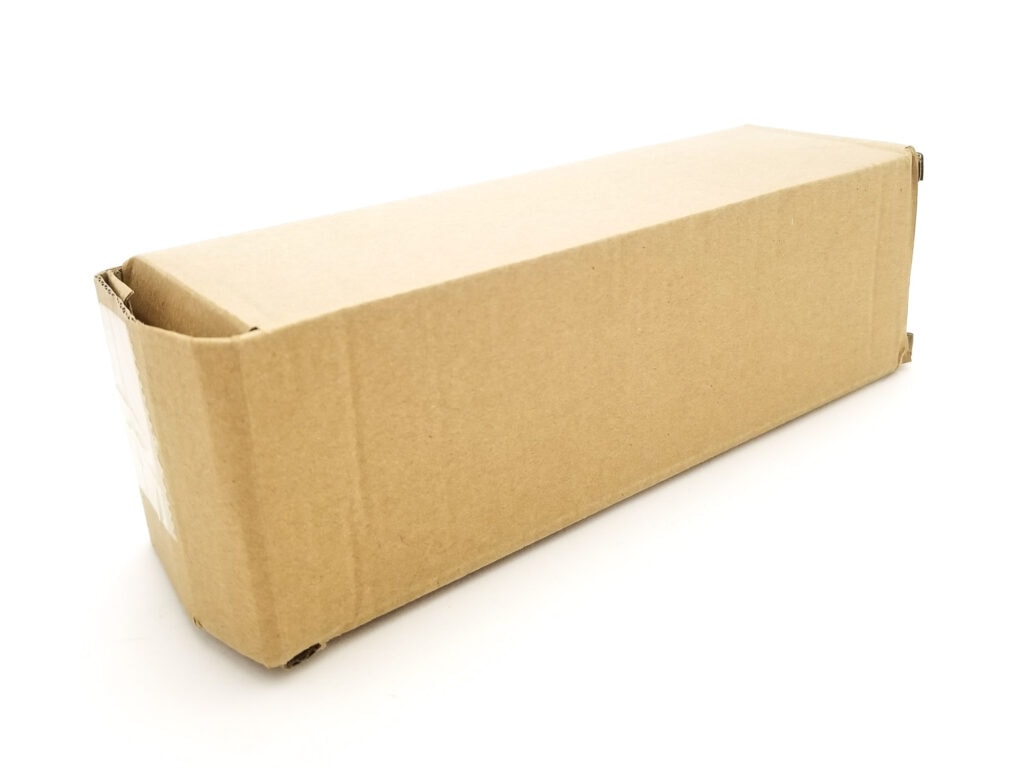
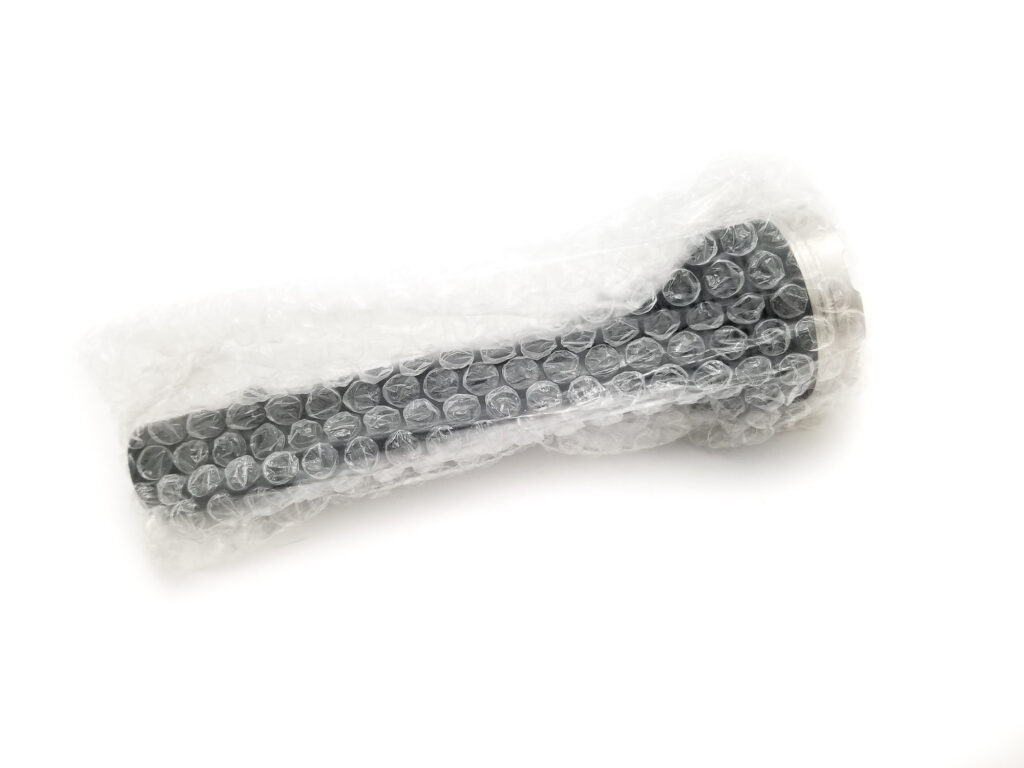
Flashlight in use
A flashlight, in the general sense of the term, is a portable illumination tool. It puts light where there isn’t any, and some do a better job than others. One generally selects a flashlight with an appropriate output level for the application. The NS14 is a pretty versatile illumination tool and can make a little light, or a lot of light, and it works where a C8 or Convoy S2+ would. However, as a 2×21700 format light, it’s not as maneuverable as either of those. It reminds me of a German ‘potato masher’ grenade, and there’s a lot of weight at the head, and the balance point is pretty good despite having a long narrow battery tube.
Unlike the original NS59v1, the NS14 eschewed the two piece tube and now features a single piece battery tube. I actually like this better than the two piece tube, and it seems Nightwatch has bored it out a bit since the batteries don’t get stuck in the tube like the prior light. The light is also missing the anti-seize like lubricant on the threads, which is fine with me. The knurling is a bit different also, and the knurling bands on the head, battery tube, and tailcap are a bit narrower and a bit finer this time, but seem a bit prouder and more grippy.
Everything else looks the same though. It’s a one or two-handed light, and Nightwatch adds a tactical ring at the rear and front. These are removable and feature lanyard holes for attaching a shoulder strap or lanyard. The rear ring can rotate, but the front ring is fixed. Tail standing is possible, but it’s so top heavy that I don’t recommend it since it’s about as stable as a celebrity marriage. There’s no anti-roll features so it will roll off the table and cause…chaos.
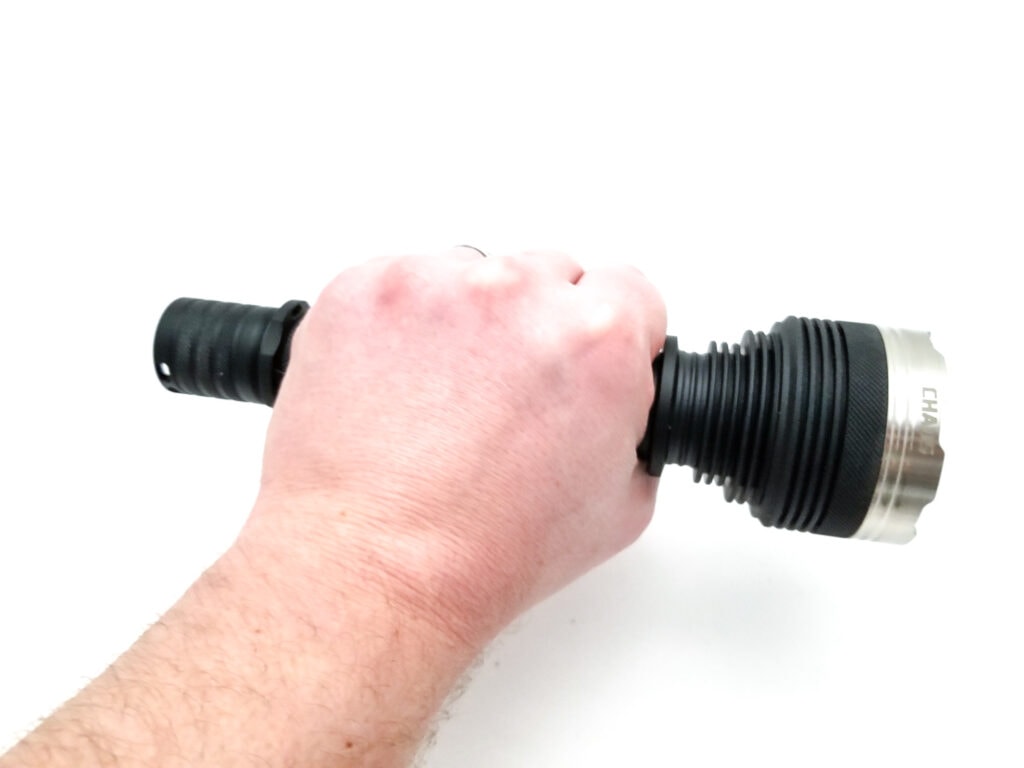
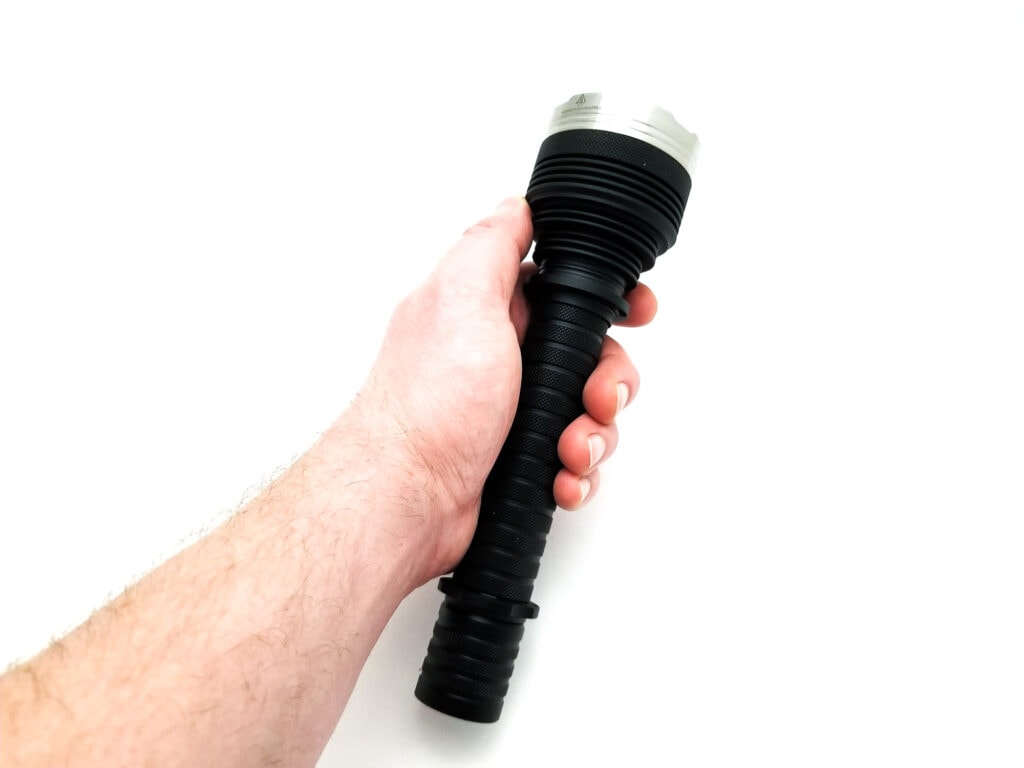
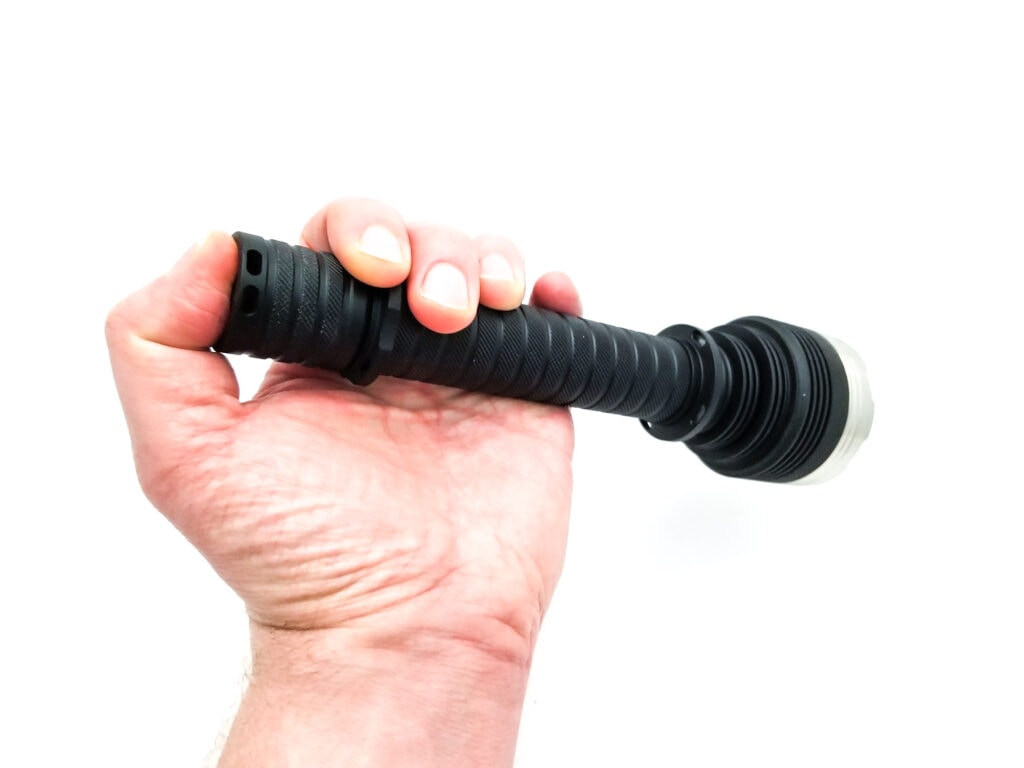
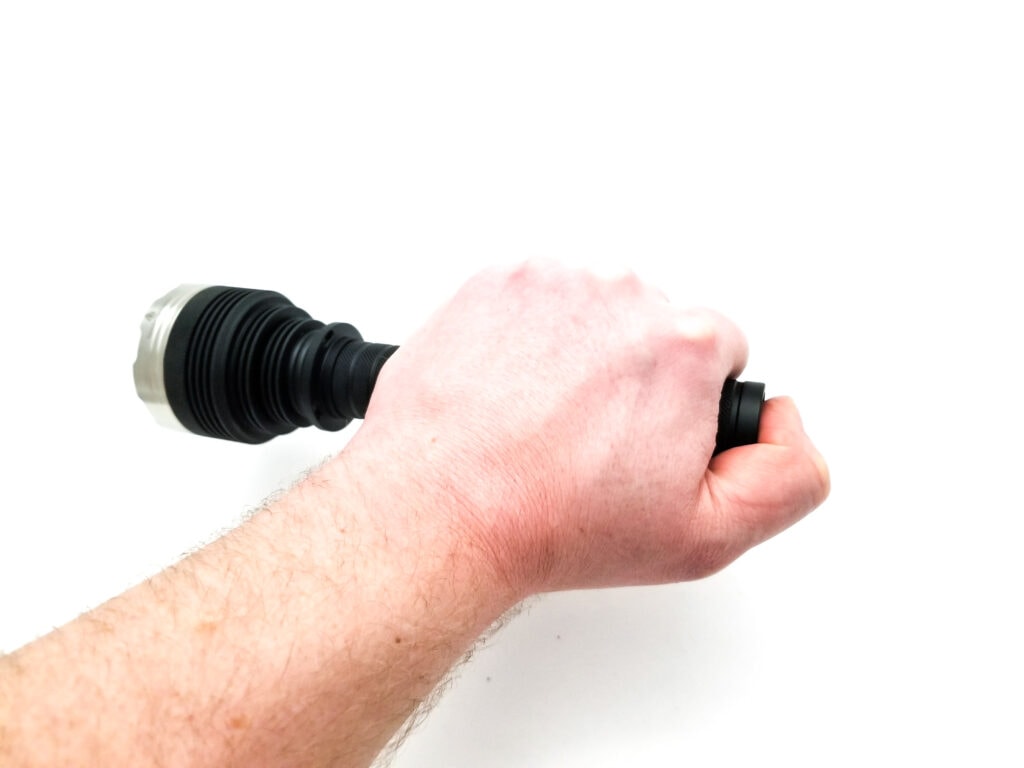
Build Quality and Warranty
Nightwatch lights are generally well-made and the NS14 carries that forward with more than acceptable build quality. The price is $125 US without and $150 with batteries, and our discount can bring it down even more, so for 40,000 Lumens, that’s a pretty good deal for a special flashlight.
Quality-wise, this is almost the same host as the NS59v1 and v2 lights, but it has been upgraded a bit from the v1. According to Nightwatch, the MCPCB thickness has been increased by 2 mm to 4 mm, the battery tube is now a single piece design and able to accommodate more batteries (the previous light’s tube was narrower and some batteries would get stuck), the driver efficiency has been tweaked a bit, and it’s sporting a new finish.
There’s no major faults. It fails the maracas test BAD this time due to the widened tolerances in the tube, with the batteries rattling away when shaken. Otherwise there’s no out of place gaps or misaligned parts, everything lines up nicely, and the machining is free of obvious defects or tool marks.
The bezel is stainless steel and pretty chonky and looks good. The finish is type III HA, and the finish is more matte than the prior light, which I really prefer. It’s nicely done and was free of defects.
The light is milled from aluminum alloy, so probably 6061-T6. All the edges are knocked down and smoothed as well. If you fancy to do so, the bezel can be unscrewed by hand and you can liberate the lens, reflector, and an o-ring. The solder joints look really good and the LED wires look to be 18 gauge, which is a bit thin for the current this thing will undoubtedly pull.
The driver is held in with a retaining ring, and swaps a spring for a very substantial brass slug for the positive contact. I didn’t try to remove it since the NS59 had exceedingly short LED wires. The contact surface on the brass slug is a bit roughly finished, so it might benefit from some sanding to make it smooth. The tailcap design is unchanged from the NS59v1. The switch is held in with a brass retaining ring that’s integrated into the PCB and has a short spring that’s been bypassed by a thick strip of metal to keep it from melting. The switch is a genuine Omten PBS101 rated for 250 volts and 1.5 amps, so it should be robust enough to handle the massive current loads on Turbo. The threads on the tailcap side are fully anodized, rectangular cut and pretty smooth with plenty of lube from the factory. The head end threads are bare and feature similarly beefy rectangular cut threads, and both ends are o-ring sealed. For ingress protection, I couldn’t find an IP rating in the literature or specs, but there’s no charge port, so use your imagination on that. I think this light would be okay for temporary immersion or heavy rain though.
For the warranty, it’s handled by Nealsgadgets, and Neal will take good care of you if something goes wrong with the light (defective, DOA, etc.).
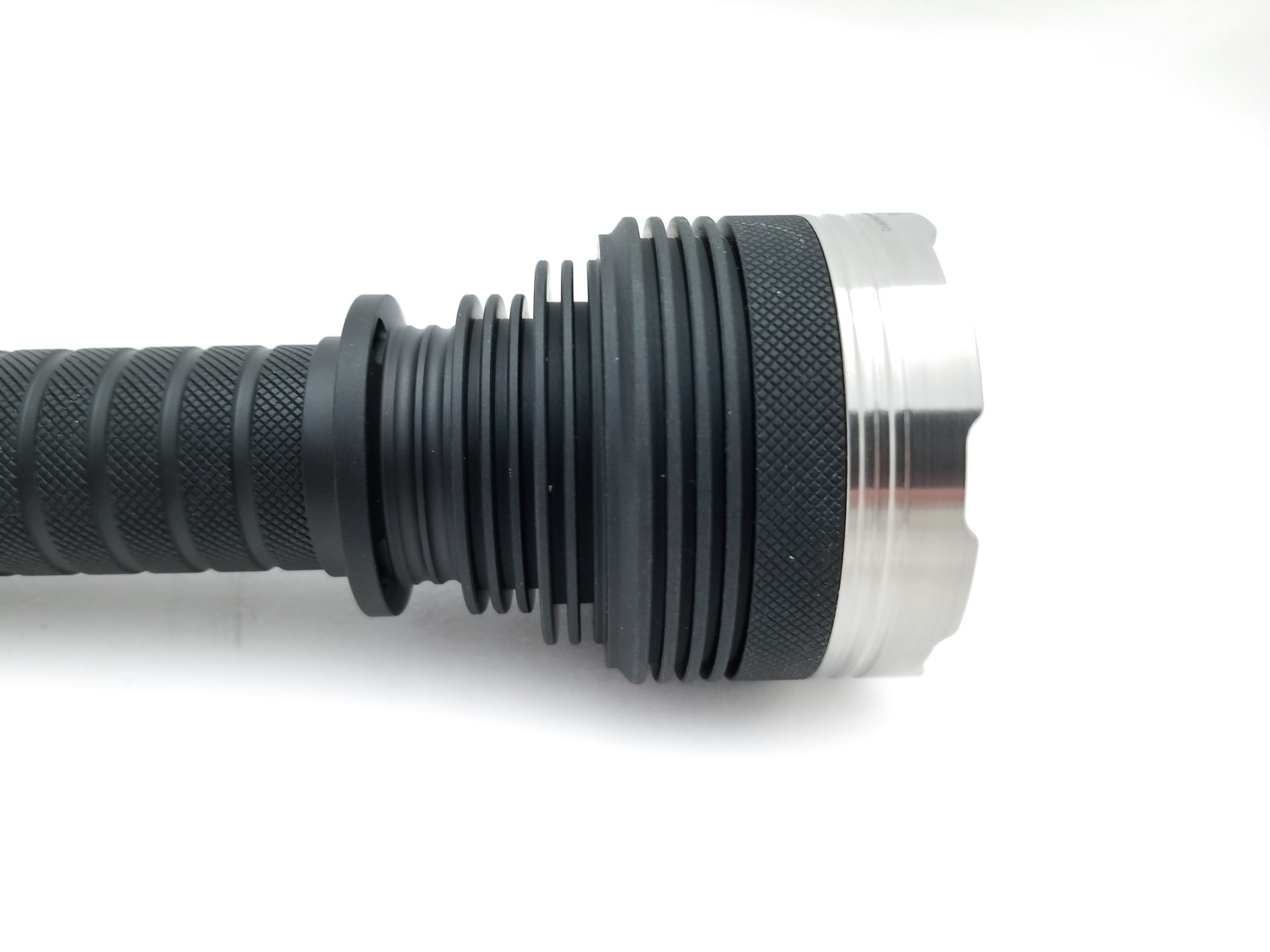
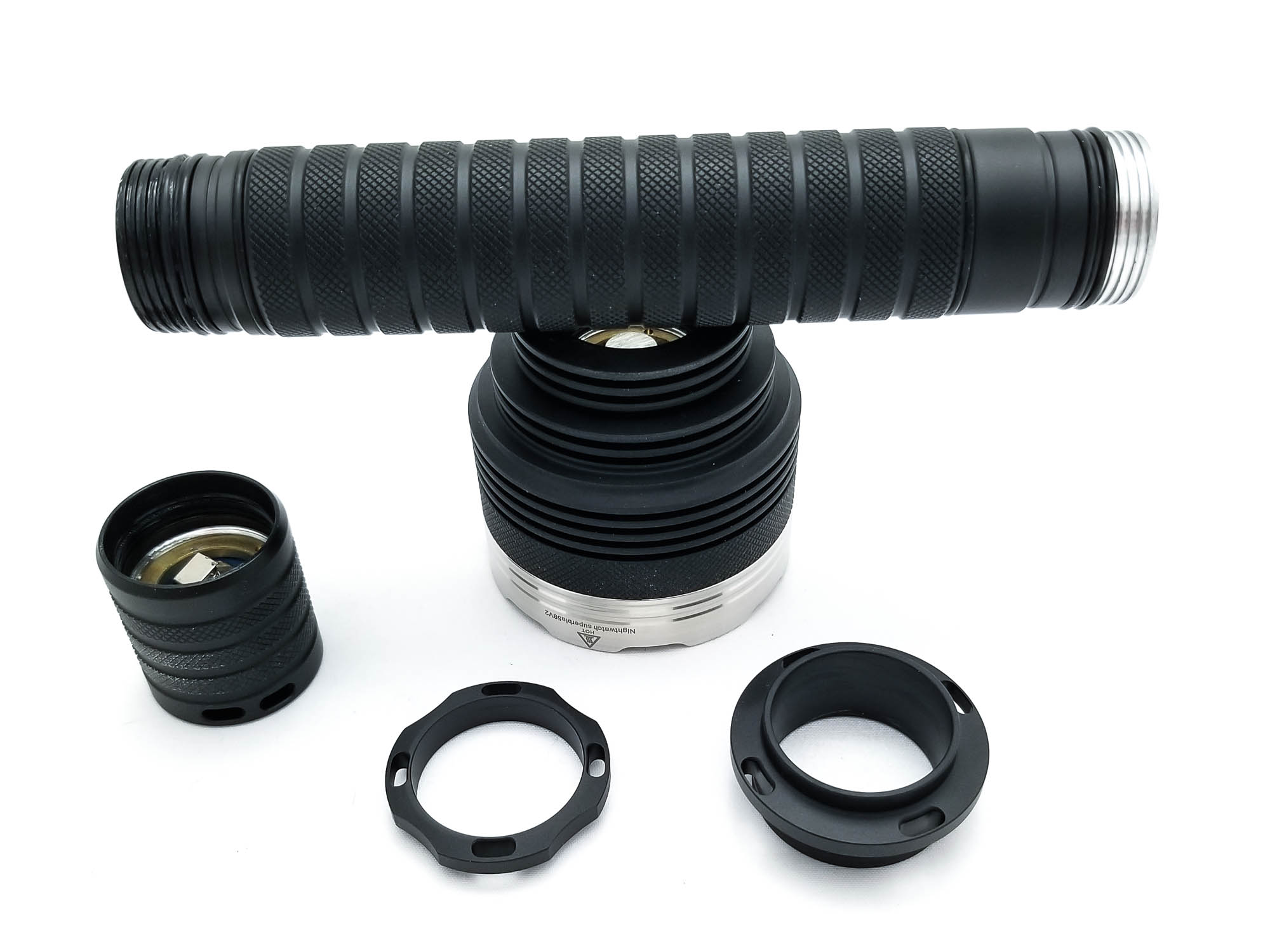
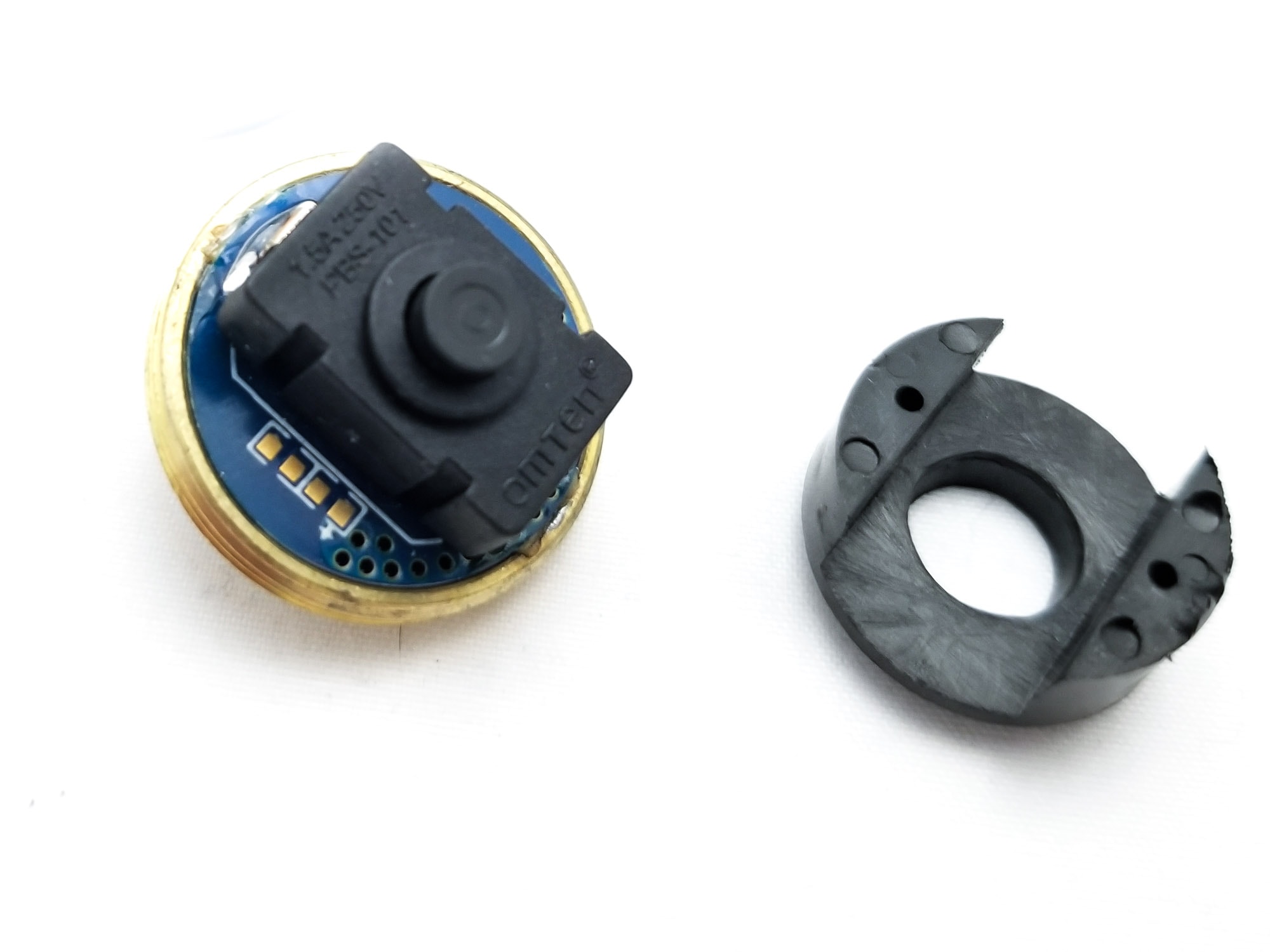
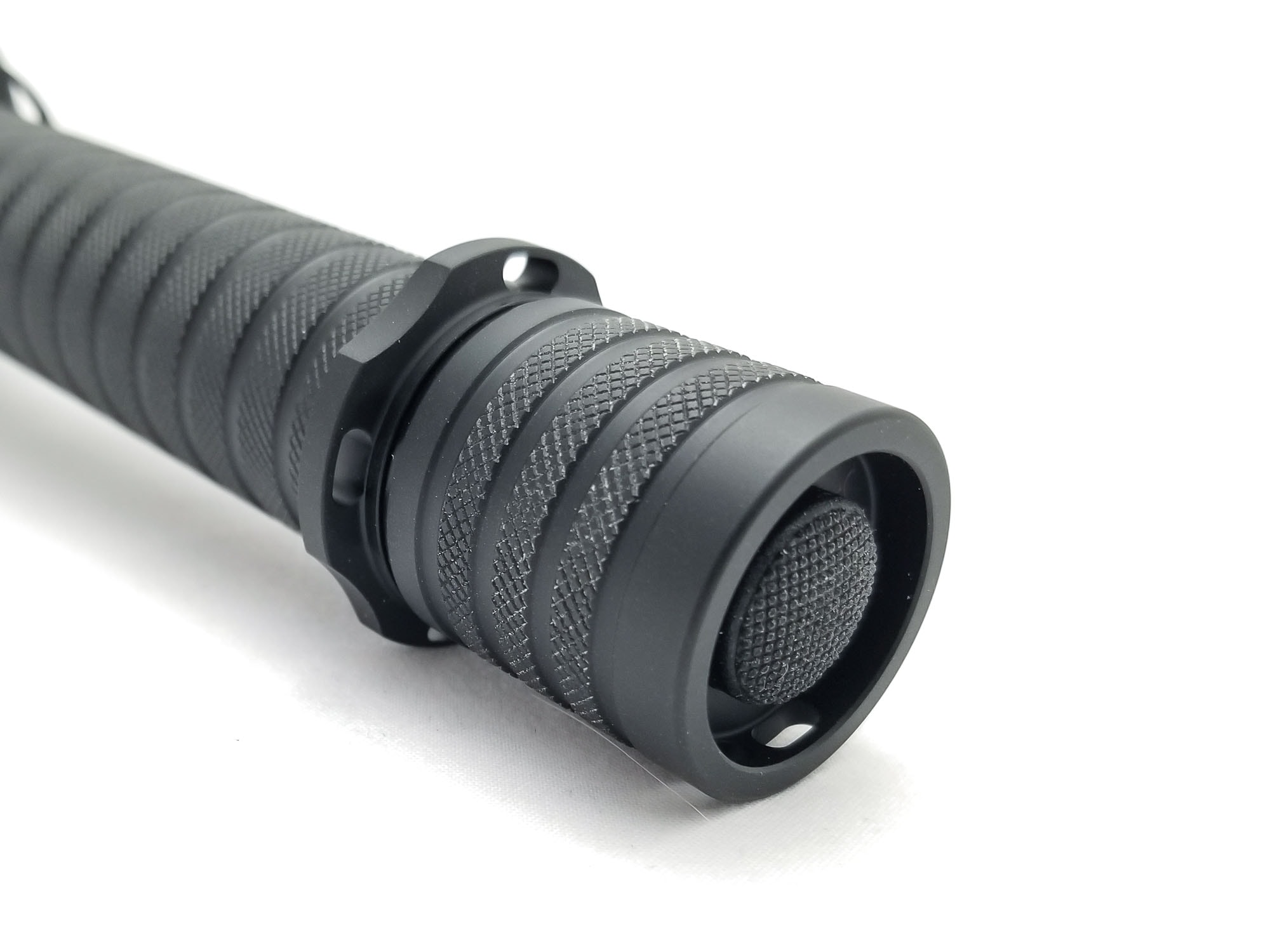
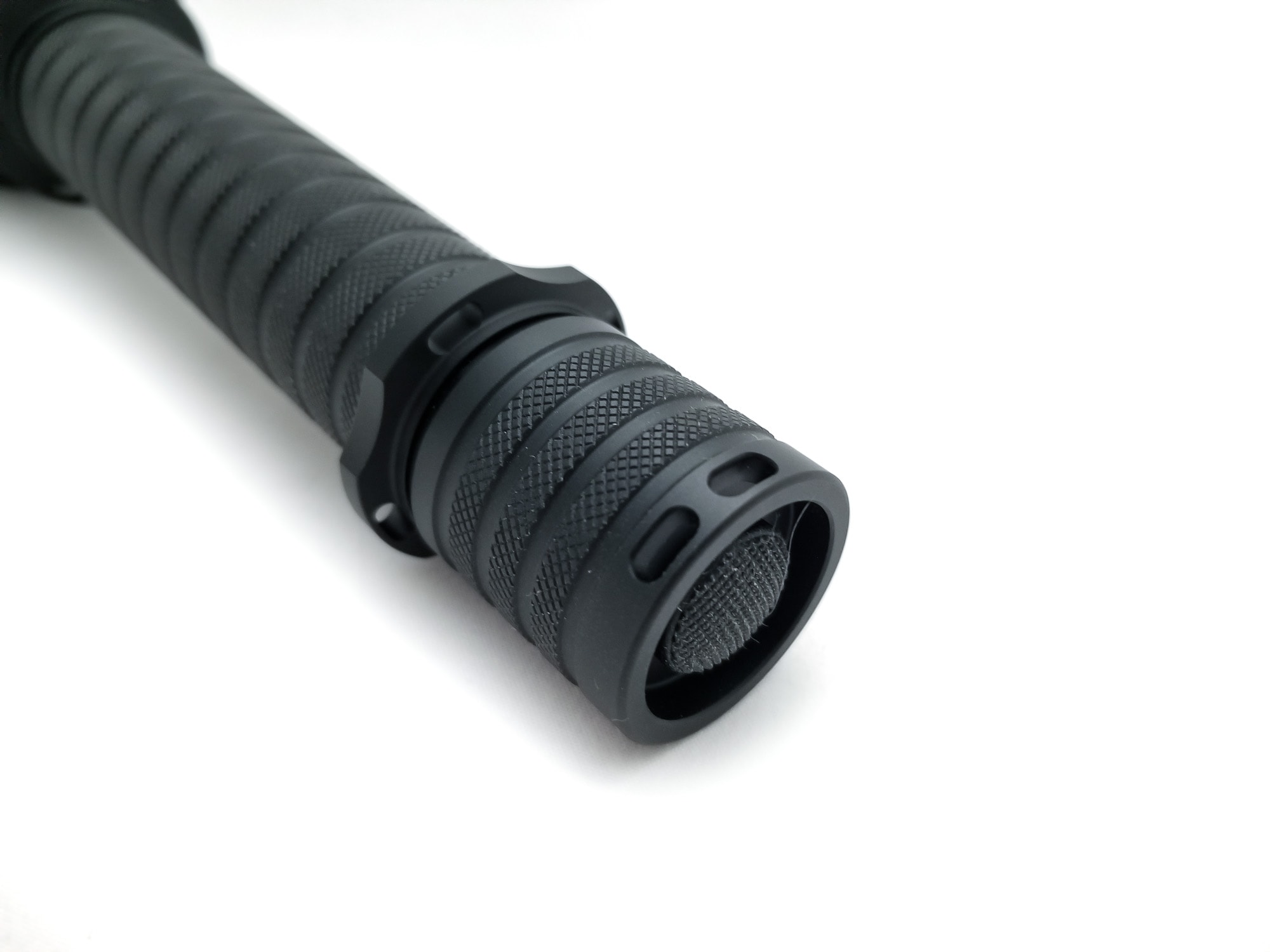
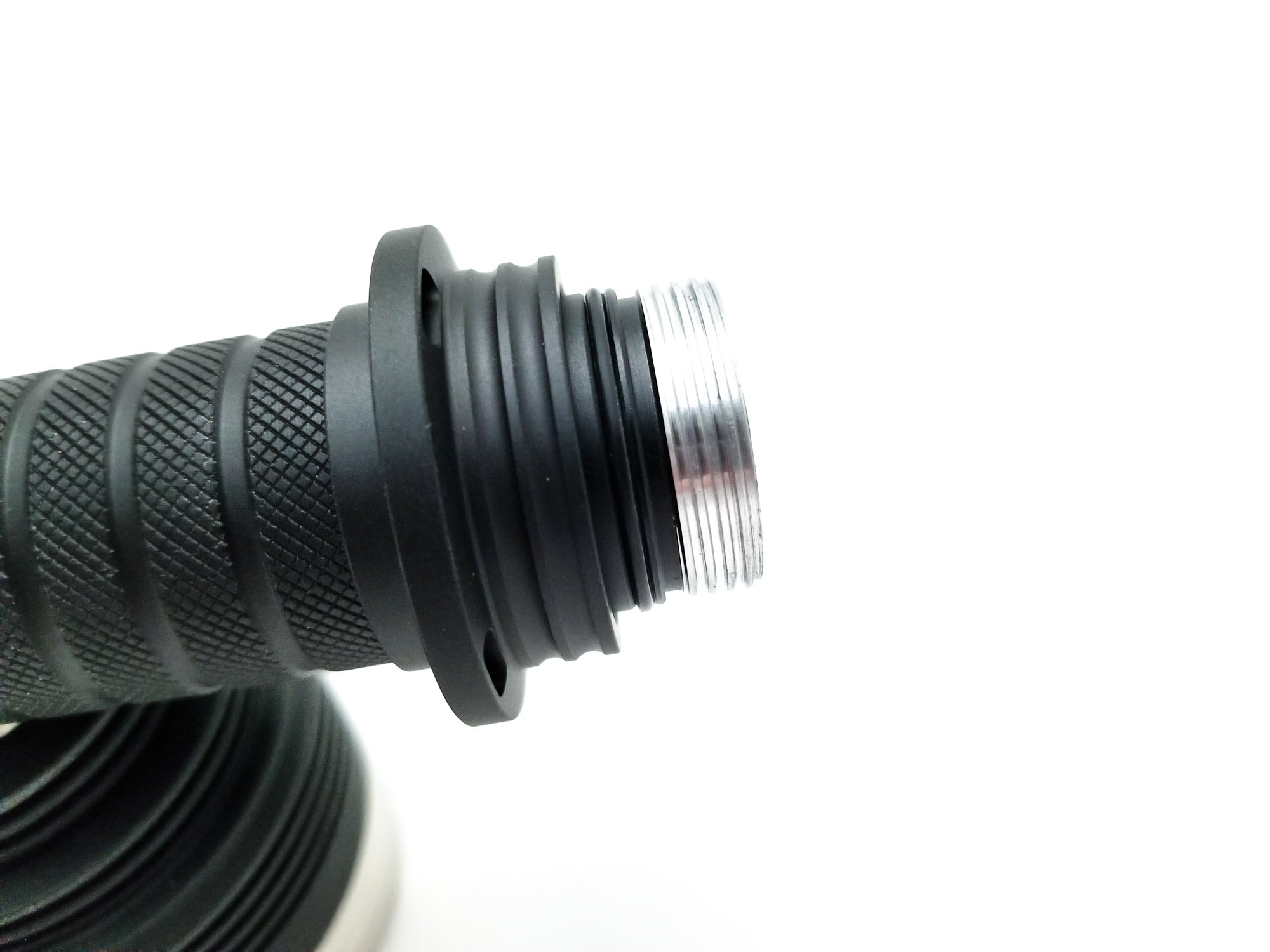
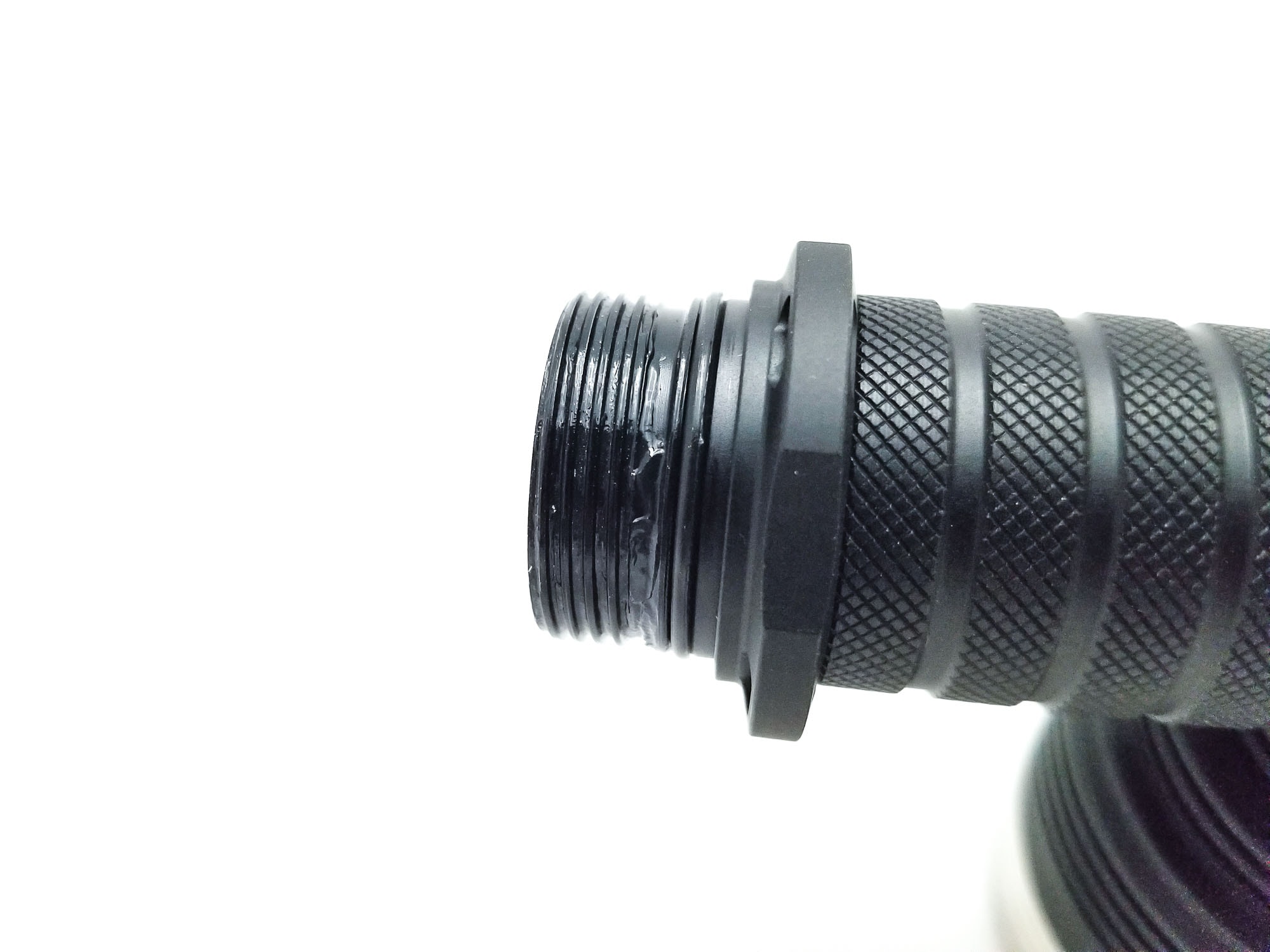
LED, Lens, Bezel, Beam, and Reflector
The NS14 gets its firepower from 14 LEDs. That’s 5 more than the NS59, and those lights featured 9 of the mysterious SFQ55 LEDs, which were dedomed Chinese clones of the Cree XHP50.2. The NS14 features the SFQ55.4, which might have some meaningful performance gains over the 1st-gen SFQ55’s. Although details are sketchy, word on the street is these LEDs (and others gracing the Nightwatch lights) are made by San’an Optoelectronics, a big LED OEM in China. The SFQ series are quad die high output domeless LEDs, with the 55 series built on the 5050 size substrate. It’s a CSP/flip chip type LED (no visible bond wires), with a roughly 6.5 mm2 LES, so it should have better throw than the XHP50.2 and perform similarly to the XHP50.3 HI. In this configuration is a 6 volt LED (confirmed via my multimeter on low mode, showing vF at 5.1 volts at the MCPCB), but it’s also available in 3 volt configuration as well. The CCT isn’t specified, but it’s going to be CW, about 6000K probably.
The bezel is stainless steel with deep, wide crenulations. It’s pretty substantial as well, and extends above the lens about 5 mm for drop protection. The lens is a dual AR coated mineral glass unit with a green AR coating to cut down on the green tints. The reflector is a 14 cup light orange peel unit made from aluminum, and it’s pretty lightly constructed. The LEDs are nicely centered and didn’t have any centering gaskets or insulators. The beam has tons of flood, with tons of side illumination and a nearly invisible hotspot. For a 14-cup reflector, it’s pretty clean, and projects as a huge wall of blinding light on High and Turbo, with very good distance. On lower settings, it’s actually a nice general purpose light for bumping around. There’s none of the discernable tint shift and chromatic aberrations I expect with domed Cree XHP LEDs either, which is nice and something I like about these SFQ LEDs.
For tint, at 1 meter from the sensor on Turbo, the Opple lightmaster Pro at CCT: 7218K and CRI Ra 71 . The duv is -0.0022, and as I’ve experienced with these Chinese LEDs, overall the tint isn’t bad for cool white LEDs.
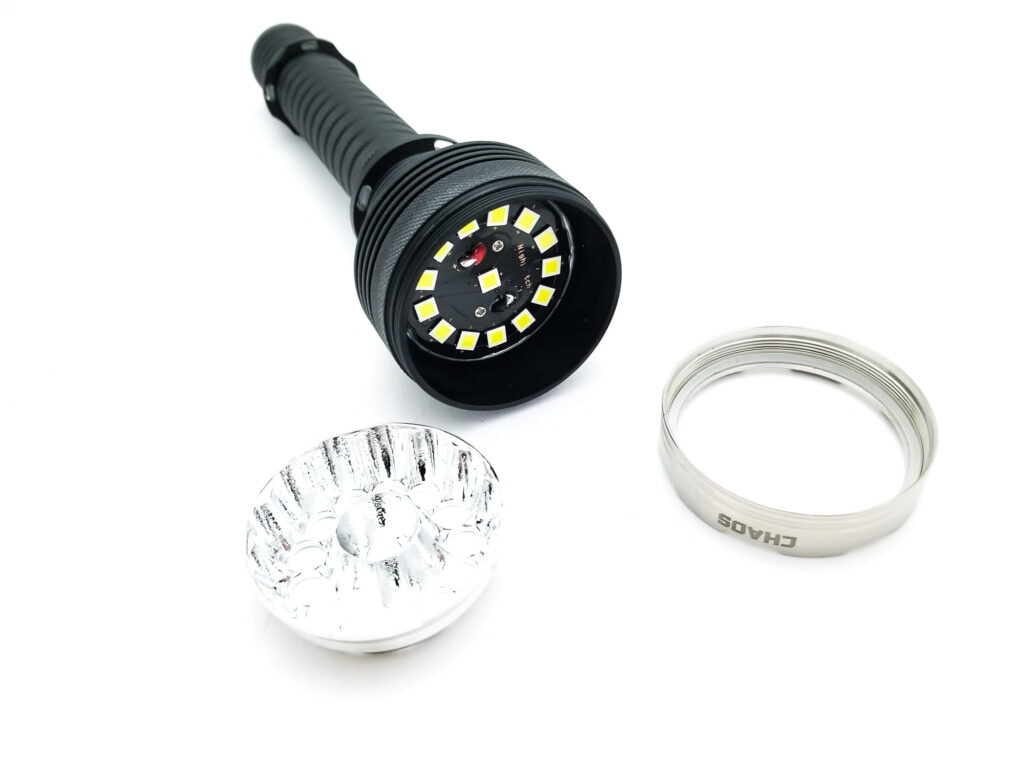
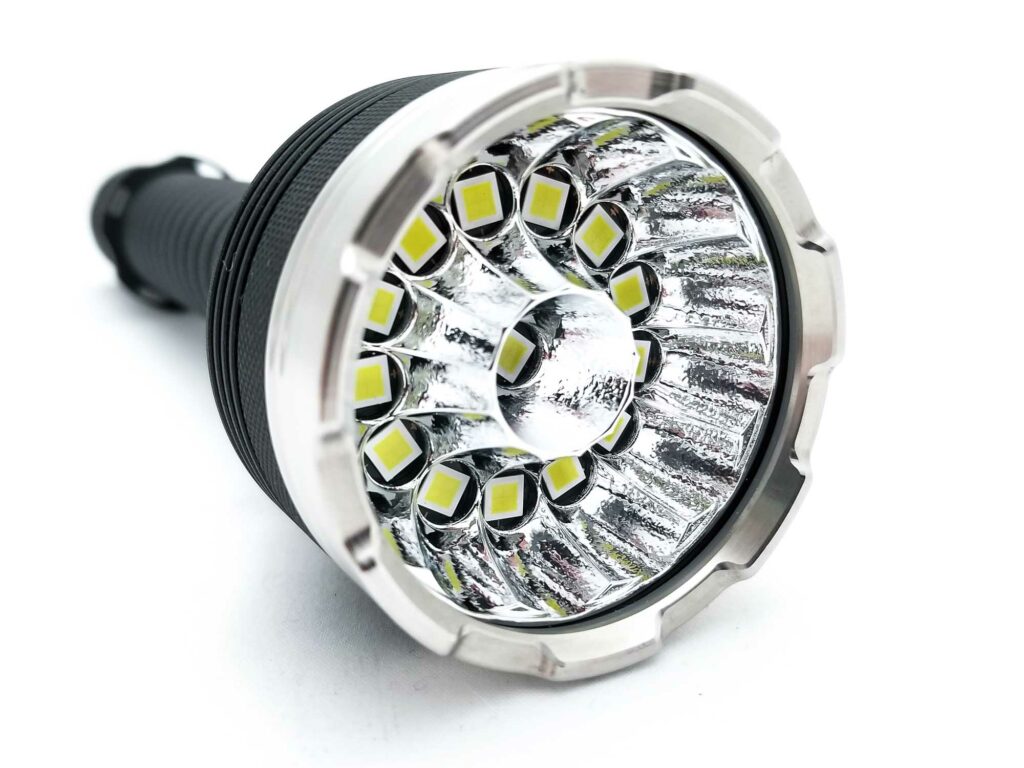
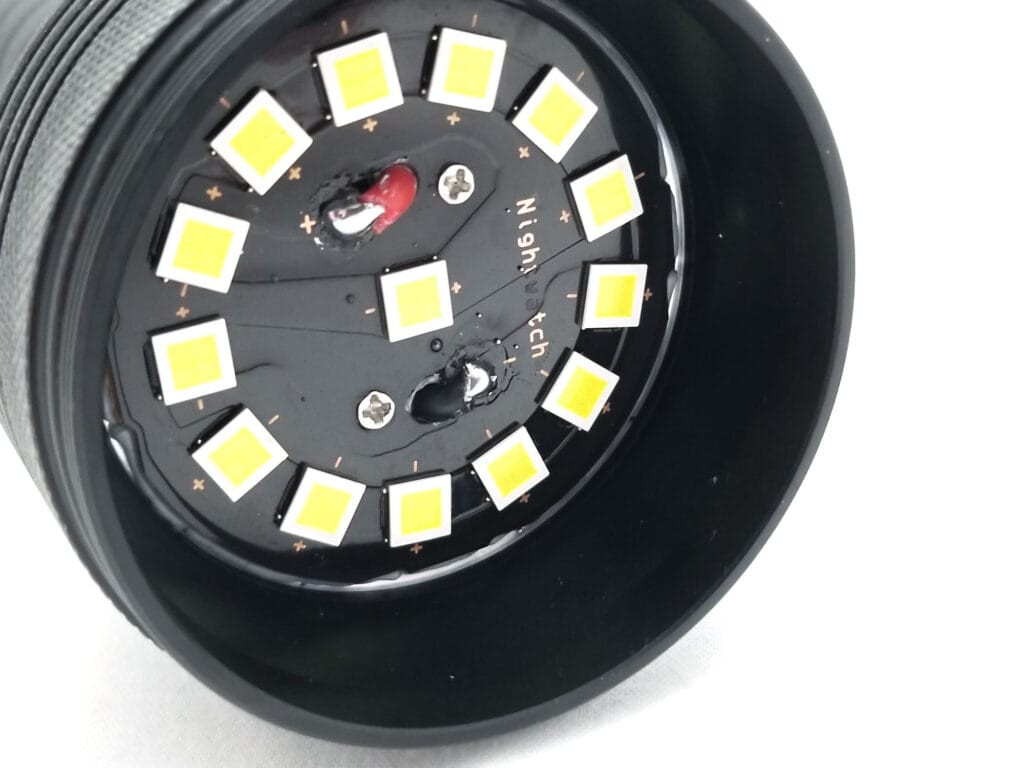
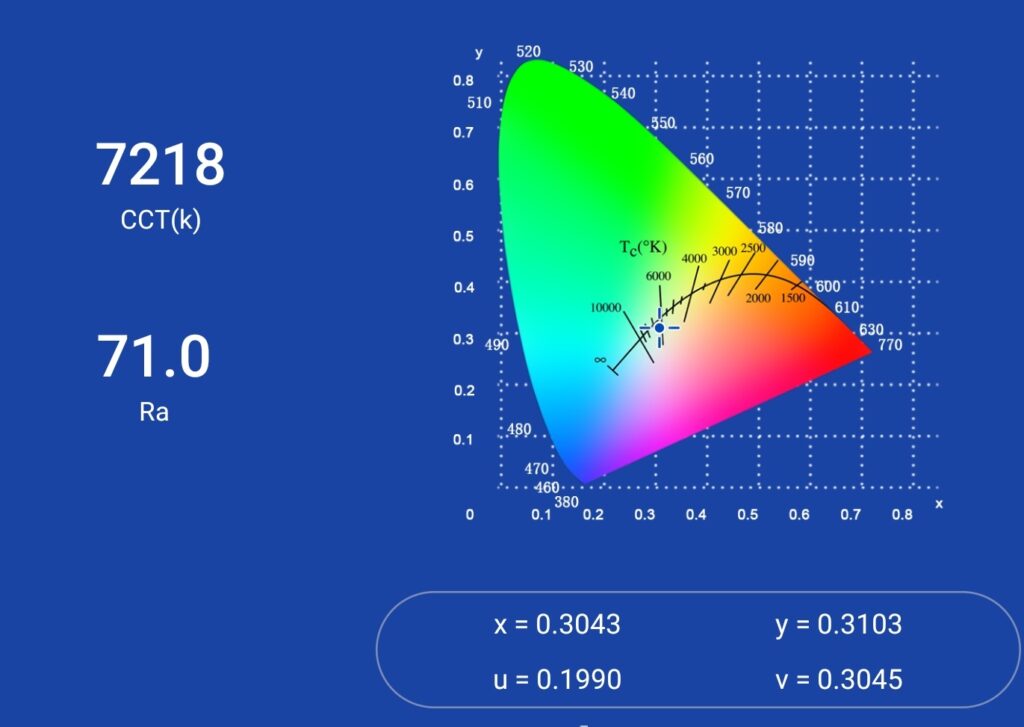
Dimensions and its competition
Dimensions:
| Nightwatch NS14 | Millimeters | Inches |
|---|---|---|
| Length | 215 mm | 8.4in |
| Head diameter | 58 mm | 2.3 in |
| Body diameter | 27 mm | 1 in |
Dimensions are rounded to the nearest millimeter, and to the nearest tenth of an Inch.
Weight:
| Nightwatch NS14 | Weight in grams | Weight in oz |
|---|---|---|
| Without batteries: | 358 g | 13 oz |
| With 2 Lishen 2170 HP | 497 g | 18 oz |
Weight is rounded to the nearest gram, and to the nearest tenth of an Oz.
Flashlight size comparison with its competition:
Compared to some other extremely bright flashlights
Group 1 left to right: Wurkkos DL70, Nightwatch NS14, Nightwatch NS59v1, Lumintop PK21, Speras P10R
Group 2 left to right: Convoy S2+, Nightwatch NS14, Thorfire C8, Astrolux FT02S
Group 3 top to bottom: Nightwatch NS14, Nightwatch NI03S Valkyrie, Nightwatch NG01 Legend
Group 4 top to bottom: Nightwatch NS14, Nightwatch NS59v1
Group 5 left to right: Wurkkos TS32, Amutorch DM80, Nightwatch NS14, Thrunite TN50
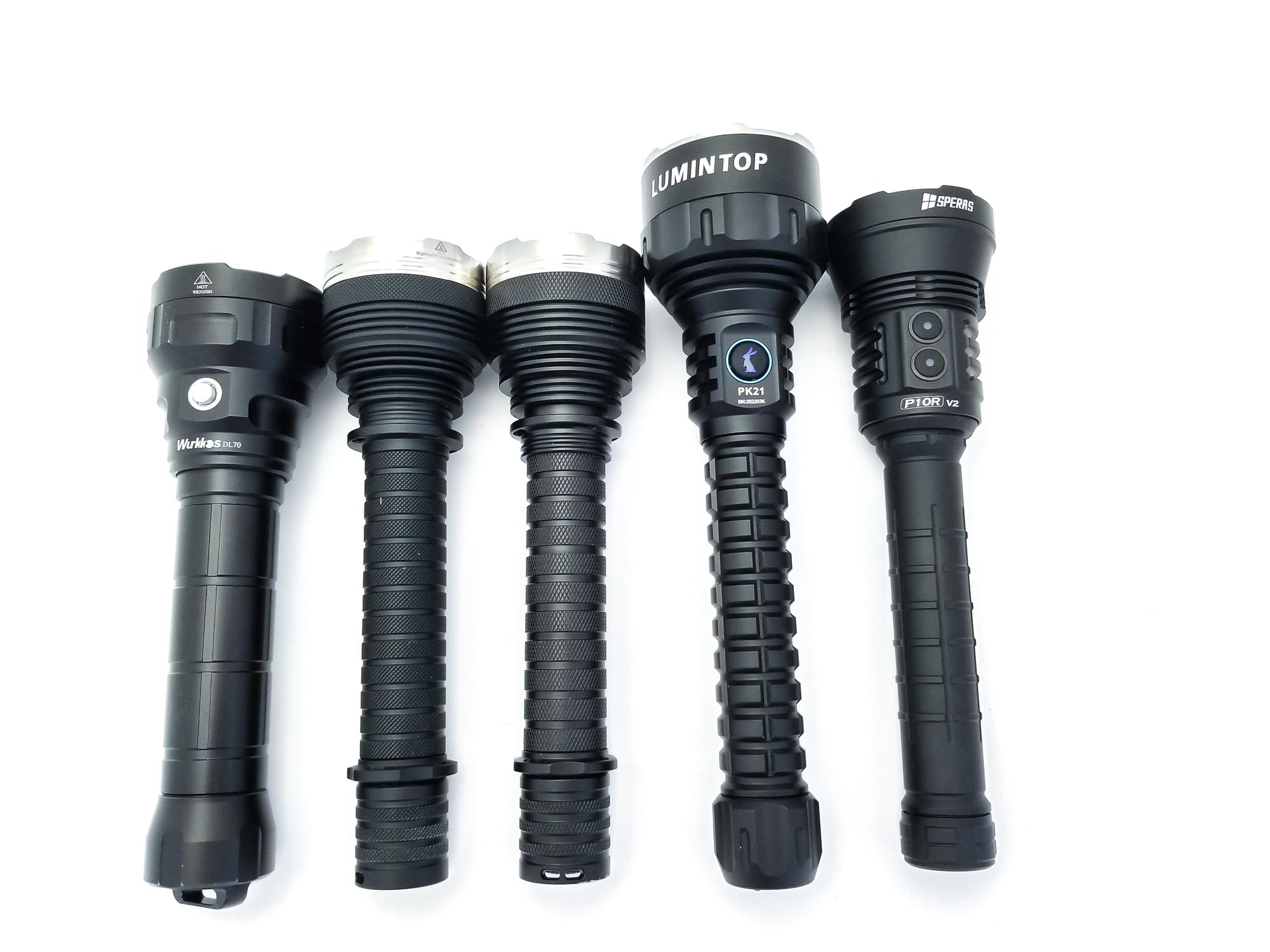
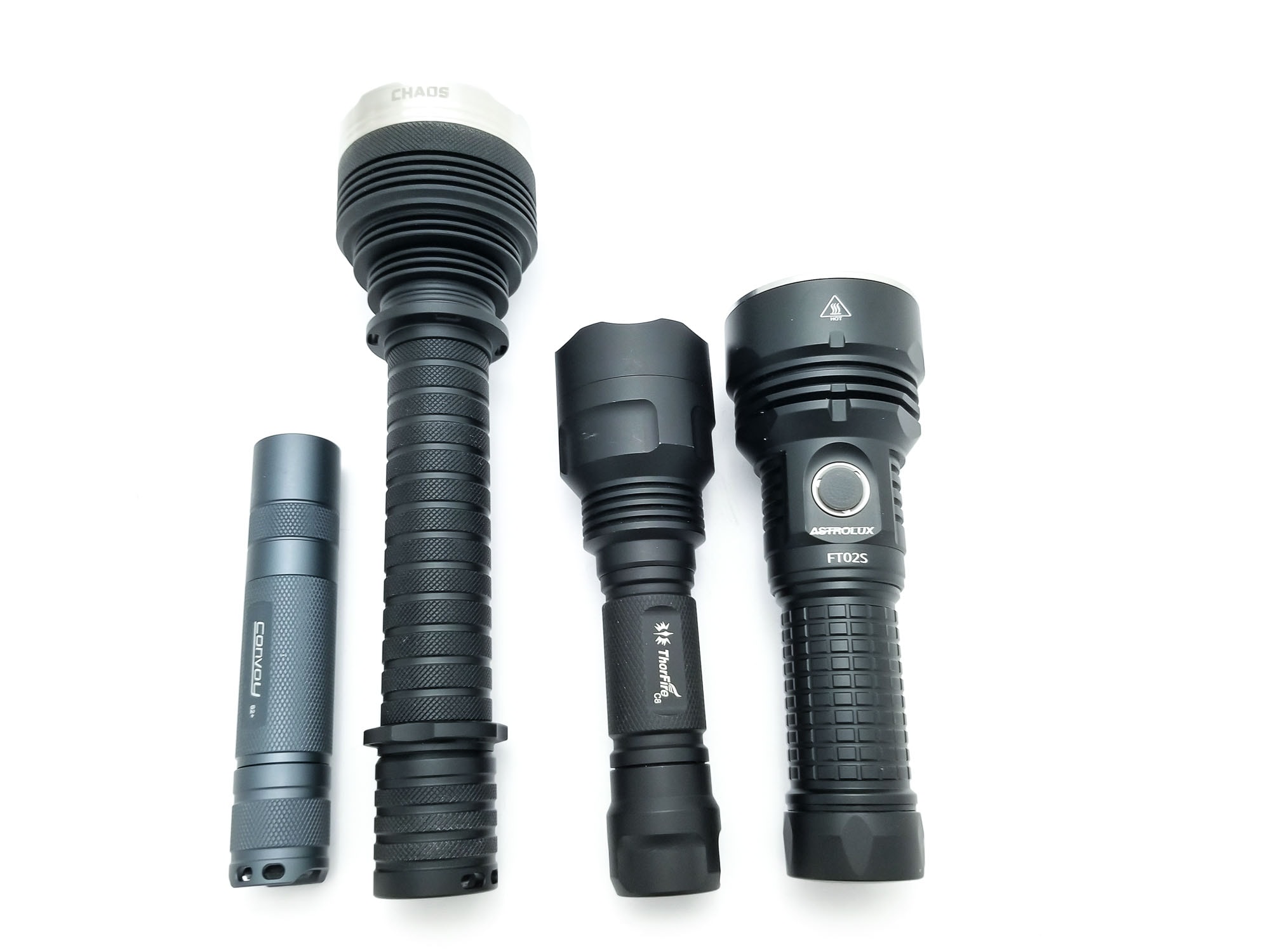
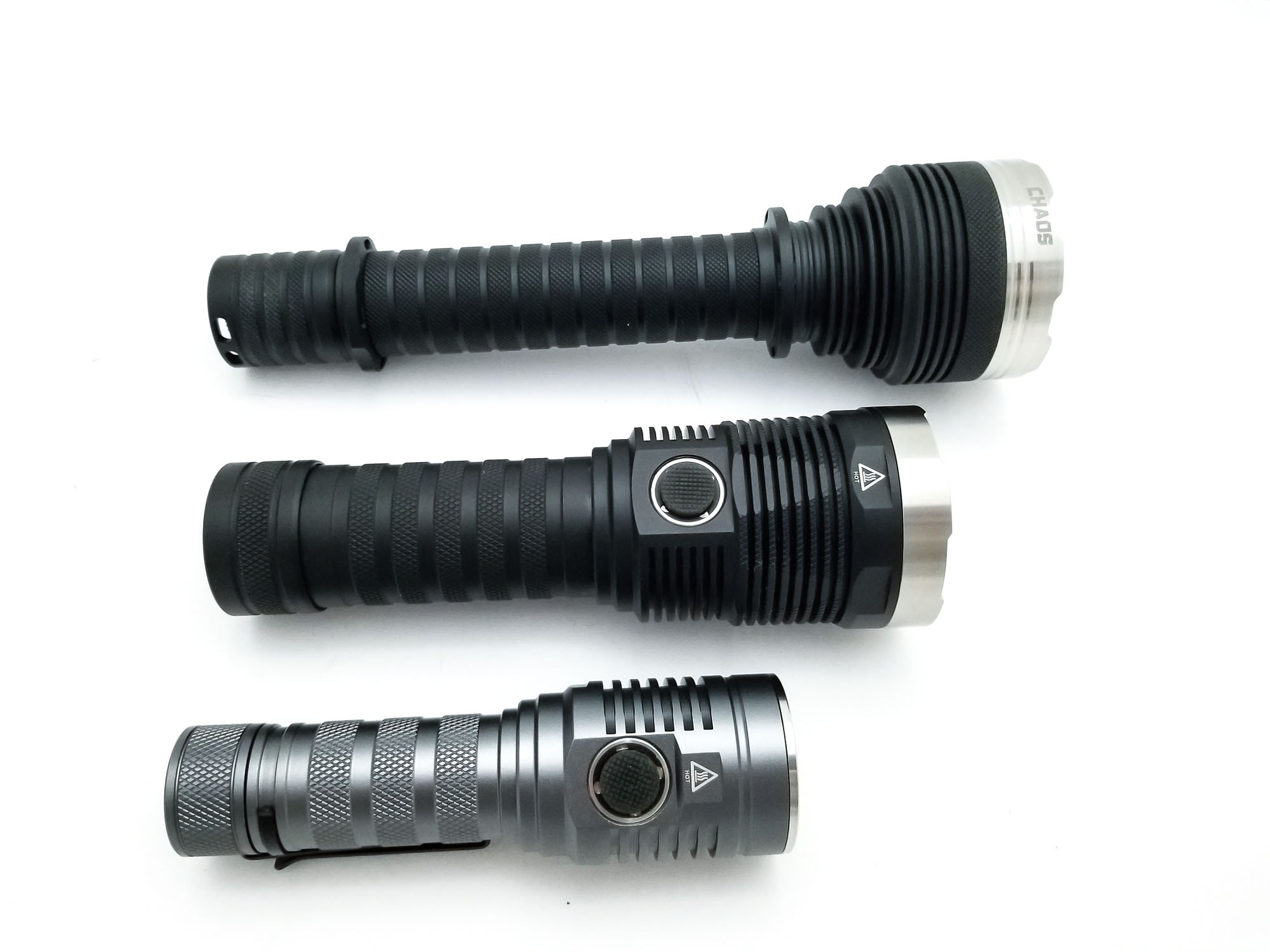
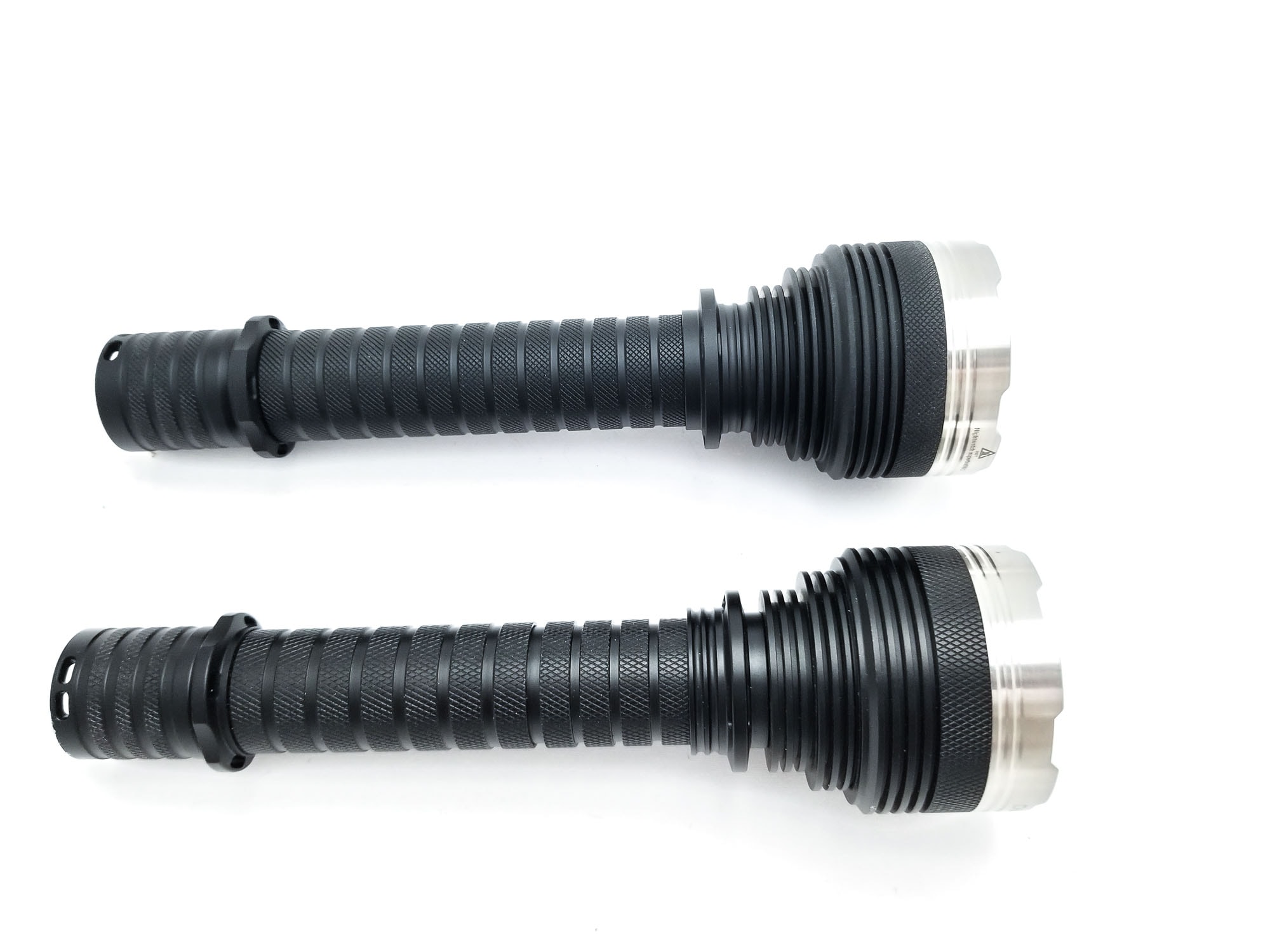
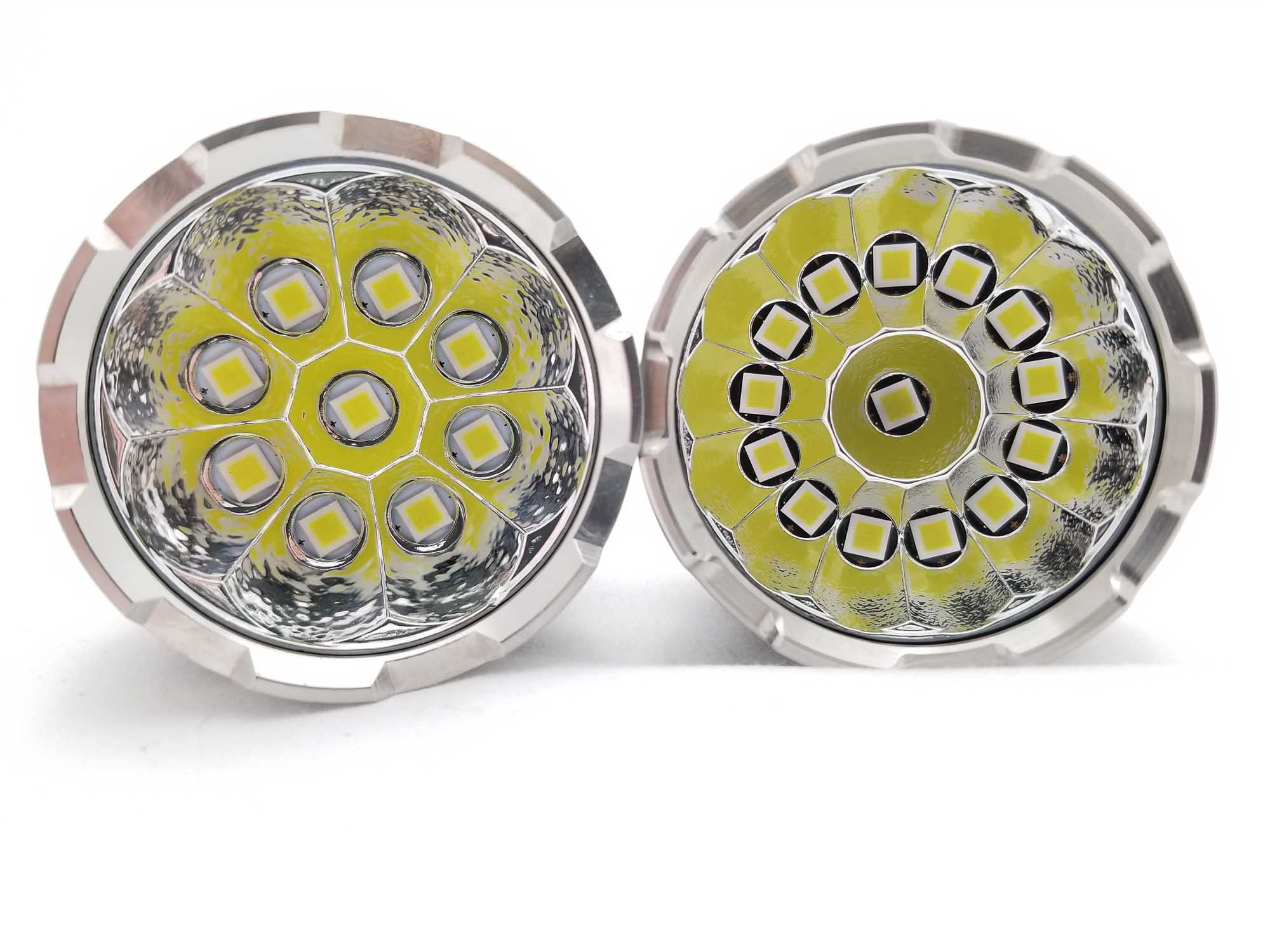
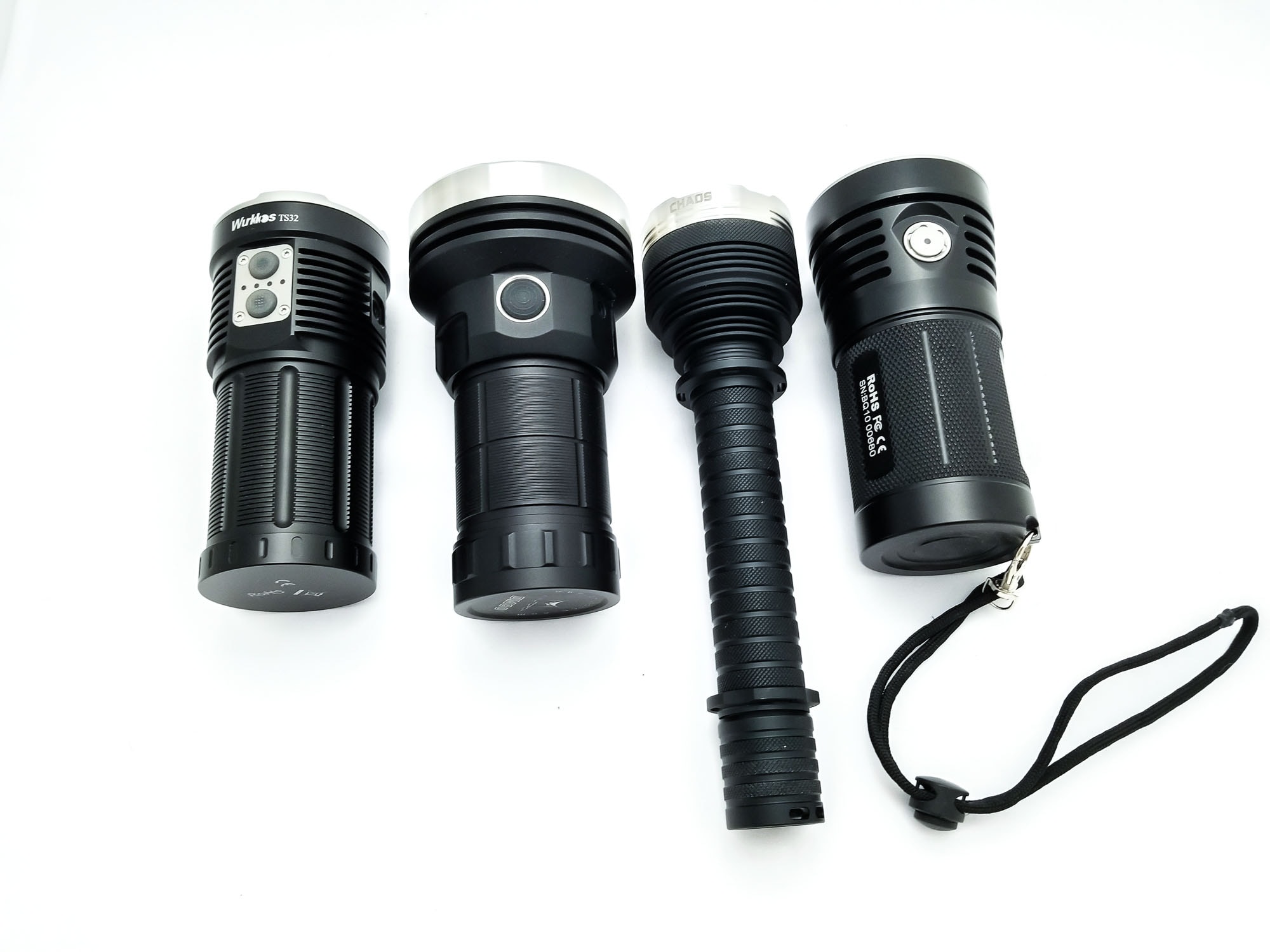
Nightwatch NS14 UI: User Interface and Driver
This light runs two cells in series with 6 volt LEDs, so there may be a buck driver on board with a direct drive FET channel. That, or this thing is pure direct drive controlled by PWM. The runtimes will tell. The UI is pretty much borrowed from the previous NSxxxxxx lights, so there’s no major differences here. It’s a pretty straightforward UI with 4 modes, Turbo, and Strobe all controlled by taps from the reverse switch. However, like the previous NS UI, some of the undesirable traits have also been carried over to this light.
Available modes:
- Moon, Low, Medium, High, Turbo
Available blinky modes:
- Strobe
From OFF:
- Single click switch: Turns on in last memorized mode
- Double tap switch: Turbo
- Triple tap switch: Strobe
From ON:
- Single click switch: Turns off
- Half-press/tap switch: Changes modes
- Double tap switch: Turbo
- Triple tap switch: Strobe
Mode memory:
- Last mode memory for the main mode group: Moon-L-M-H
Shortcuts:
- Double tap for Turbo
- Triple tap for Strobe
Low voltage warning:
- The light is supposed to have LVP
Strobe/blinkies
- Strobe
Lock-out mode:
- Manual lockout by unscrewing the battery tube ⅛ turn
PWM
- Fast PWM on all modes not visible with the naked eye
Additional/summary info on the UI:
- Once again, this is a pretty simple and straightforward UI, typical of Nightwatch UIs and adapted nicely for mechanical clicky use. The modes are sort of misleading, since I estimate the light to have a Moon, Low, Medium, High, and then double tap for Turbo. I didn’t see an additional ‘middle 2’ mode in the mode group, so I’m not sure if that’s a typo or not? The light didn’t come with a manual, so I’m only going off what I gleaned from Nealsgadgets and other product pages featuring the NS14.
- The obvious issues with the mode spacing are present here just like the original, and Moon is not so moonlight-y at around 600 Lumens, with big jumps in output across the modes. The jump from Middle 1 to High is 6000 to 24000 Lumens. The last light had LVP and temperature regulation, and both of those are mission-critical here to keep it from destroying itself (and your fancy 60A batteries). However, some readers might remember from the NS59v1 review that the previous NS59v1’s LVP had a bad day at the office and went home early after the Turbo runtime test and nearly killed the batteries. Also like the NS59v1, you need to be deliberate and calculating when changing modes, since it requires careful timing and a light touch to master the mode changes, especially going into Turbo.
Nightwatch NS14 Charging and batteries
The NS series have always been dual cell lights, with two 21700 size batteries arranged in series. This is more of a necessity of design and power demands since it’s easier to drive 6 volt LEDs off series cells. Since the series connection doubles the voltage across the cells, but doesn’t increase the current handling like parallel does, it is recommended to use high drain cells capable of handling over 40 amps CDR. That cuts the list of compatible cells down to either the Samsung 30T, Molicel P45B, Molicel P42A, or Neal’s special Lishen-made LR2170HP cells he sells with the light.
Since this NS14 didn’t come with batteries, I’ve borrowed the ones from the NS59v1 (I’m sure it won’t mind), and it really needs these batteries to get the most output. These are the gray version, and they’re rated for 60 amps! You can use lower-current cells, but the light won’t run at max output, and you might damage the batteries. They must also be button tops, since flat tops won’t create a reliable connection (if at all). The tailspring doesn’t have much to give in terms of compression, so using long button tops with protection circuits is a no-go. I noticed that the batteries are a less snug fit in the tube with the NS14, which is nice since they don’t get stuck in there like with the NS59v1, but bad in that this rattles like a maraca, and that could mean potential connection issues. There’s no onboard charging, so you’ll need an appropriate 21700 li-ion charger.
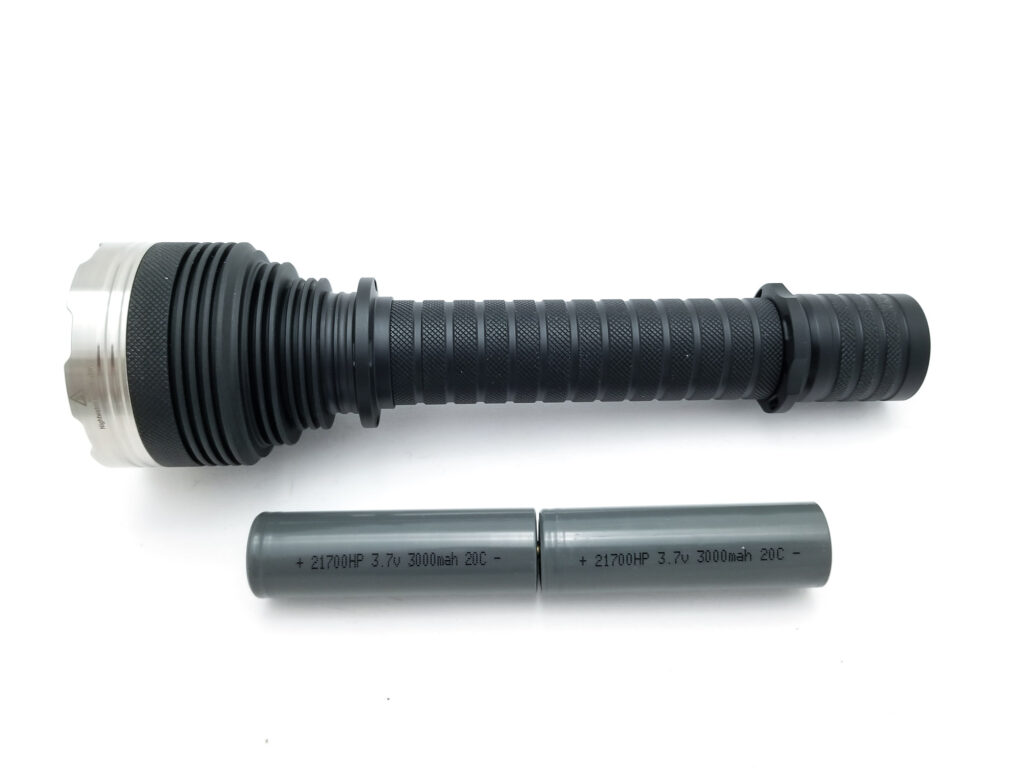
Performance test
Lumen measurements
How Lumens are Measured: Understanding ANSI FL1 Standards How Lumens are Measured: Understanding ANSI FL1 Standards: The ANSI FL1 standards specify that output in lumens should be measured 30 seconds after turning on, as this is the standardized time for measuring brightness according to the industry standard. This is why we focus on this part in our measurements. The ANSI FL1 standards require an ambient temperature of 22 ± 3°C. We record the ambient the ambient temperature to identify potential reasons for any observed discrepancies.Lumens are measured in my 50 cm integrating sphere with a Digi-Sense 20250-00 data logging luxmeter. The sphere has been calibrated with a Convoy S2+ measured to 260 Lumens and the figures are within 10% of actual. Current was measured with my Thisinde B18B+ multimeter with 14 gauge wires on banana plugs in the meter and high currents with my FY219 clamp meter with a piece of 10 gauge wire in the loop. Measurements were taken using fully charged Lishen LR2170HP 3000 mAh 21700s.
| Mode | Amps at start | Specified | turn on | 30 sec | 10 minutes |
|---|---|---|---|---|---|
| Moon | 0.4 amps | 650 | 418 lm | – | – |
| Low | 1.59 amps | 2900 | 1734 lm | 1734 lm | 1722 lm |
| Medium | 4.13 amps | 6000 | 3936 lm | 3936 lm | 1722 lm |
| High | 29 amps | 24,000 | 15,498 lm | 16,605 lm | 0 |
| Turbo | 55 amps | 43,000 | 28,905 lm | 20,664 lm | 1599 lm |
So, we’re way down from the advertised output specs, which is surprising since the NS59v1 got close to its claimed output. Turbo is down nearly 30% from advertised, which is kind of lame because I was expecting more. The Low and Medium modes are a bit better, but still down. Turbo drops to 30 amps by 30 seconds, and I tested Turbo with Samsung 30T 21700s to see how it affected the output, and I got the same 55 amps at start, dropping to 30.8 amps by 30 seconds. I wouldn’t really subject any other batteries to this kind of punishment, since 55 amps for a single battery is a lot. Even 30Ts aren’t rated for that, and prolonged exposure to these high currents can damage them over time.
Parasitic drain:
- 2.28 mA
Nightwatch NS14 Battery Life: Runtime graphs
How Runtimes are Measured: Understanding ANSI FL1 Standards About ANSI FL1 runtime standards: The runtime is measured until the light drops to 10% of its initial output (30 seconds after turning on). This does not mean that the flashlight is not usable anymore. The last column shows how long the light actually works till it shuts off. If there is a + symbol, it means that the test was stopped at that particular point, but the light was actually still running. This happens on certain occasions, with certain drivers, firmware, or batteries.Lumens are measured in my 50 cm integrating sphere with a Digi-Sense 20250-00 data logging luxmeter. The sphere has been calibrated with a Convoy S2+ measured to 260 Lumens and the figures are within 10% of actual. I used fully charged Lishen 2170HPs for this test and tested Low, Medium, High, and Turbo modes.
| Mode | Specified | Measured runtime ANSI | Time till shut off |
|---|---|---|---|
| Low | ? | 1h 48m | 1h 48m |
| Medium | ? | 1h 44m | 1h 44m* |
| High | ? | 2m 10s | 2m 15s* |
| Turbo | ? | 1m 40s | 1h 8m |
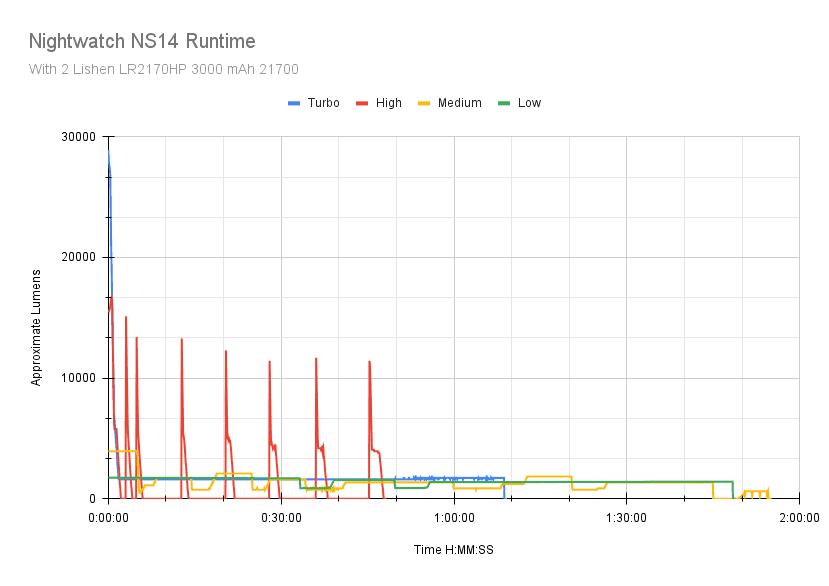
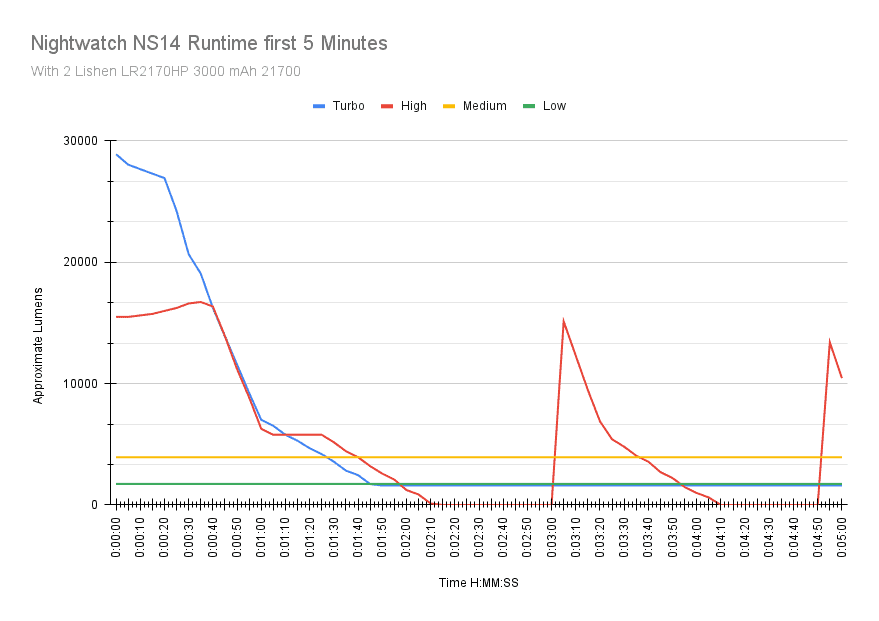
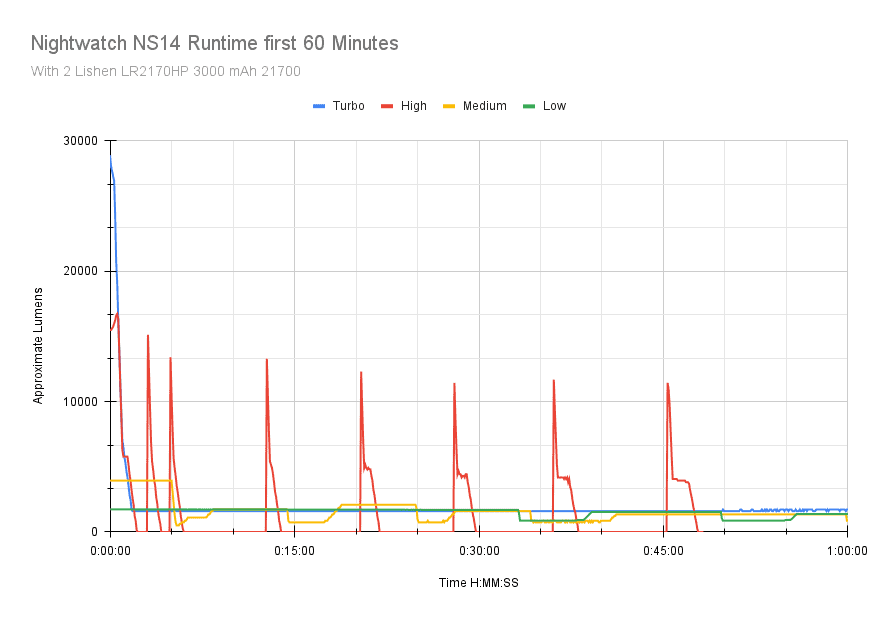
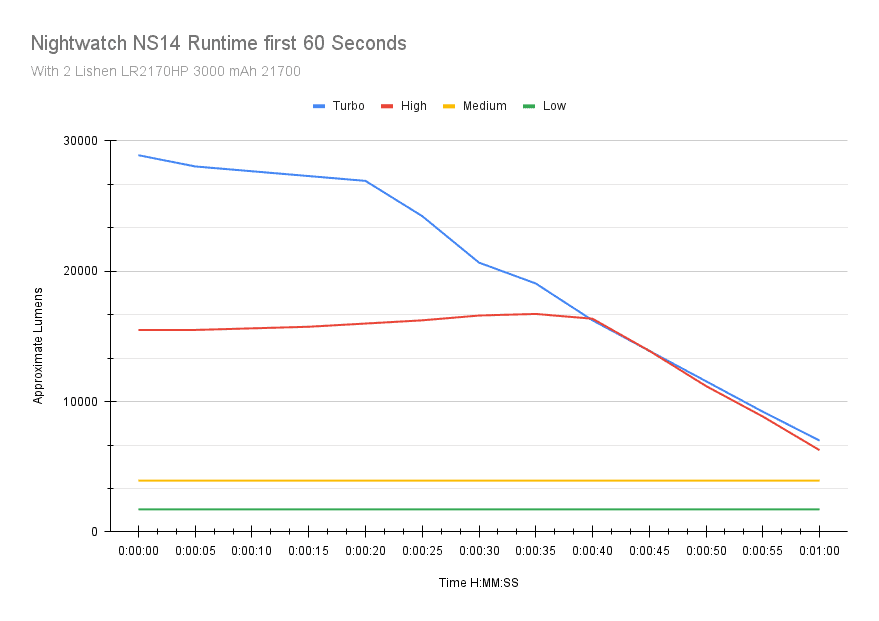
I couldn’t find runtime specs for the NS14 anywhere, so let’s use our imagination here.
*Medium and High modes exhibited unusual behavior. On Medium mode, the light shut down then restarted 5 minutes later, ran for 5 more minutes, then shut down again. Read below for more.
Generally, it’s in the runtimes that we see the biggest differences between consumer grade flashlights and enthusiast flashlights. Like with the NS59v1, it’s not designed for high sustained output, but maximum output, and we see that clearly on display here. The higher mode runtimes per ANSI are measured in minutes, with the High mode actually shutting down in 2 minutes 15 seconds. No joke. The Light acted normally for the first 2 minutes of the High test, with a steep drop from 15,000 Lumens to 1200 Lumens by 120 seconds. However, it didn’t level out, but kept dropping lower, and lower until it shut off. The light wouldn’t turn back on without cycling the switch. I reactivated High mode after 50 seconds, and it was the same story, close to 12,000 Lumens at start and down to zero in about 60 seconds. I let the light cool off for 5 minutes between reactivations to see if it would turn on by itself once it cooled below 60 C, but that didn’t happen. I repeated this 7 times over about 30 minutes with the same result. The temperature limit for the step down seems to be set to about 65 C, but instead of dropping to a lower output, the thing just shuts off!
On Turbo, the lights heats up crazy fast: From 21 C ambient the head hit 38 C by 5 seconds, 58 C by 10 seconds, and 74 C by 15 seconds, and at 20 seconds the output is dropping rapidly at 80.4 C, peaking at 81.3 C at 30 seconds. The output drops to around 1600 Lumens and stabilizes for the remainder of the runtime, eventually ‘cooling off’ to 61 C. It’s too hot to hold by 10 minutes though, even at the tip of the long battery tube.
Medium mode was probably the ‘best’ performer here, with good sustained output, abbreviated by strange step downs for cooling. The average output was 1338 Lumens, starting at about 4000 Lumens and stepping down as the temperature rose to 51 C then increasing as it cooled. Low mode had good sustained output at about 1600 Lumens for the entire 1 hour runtime with a nice, laminar output, which shows we’ve got a buck driver on board.
There’s no LVP blinks this time, just a hard shut down. Since I didn’t want to risk an LVP snafu this time, I watched for shut down on Turbo and clicked the switch off to avoid parasitic drain from continuing to drain the depleted batteries. I let Medium mode run with the switch closed after shut down to see if they fixed the LVP issue, and it seems they have. After Turbo, the cells read 3.1 volts, 3.6 volts after the truncated High test, and 2.92 volts after the Medium test.
I also included runtime graphs from comparable lights I’ve tested to show the difference between a light that’s been properly designed to handle sustained high output, and one that’s a fun machine. I compared the NS14 to the Fenix LR80R, Thrunite TN50, Amutorch DM80, and the NS59v1. The NS14 is most definitely brighter at startup, but after the step down, it’s all over, since the Fenix holds high output much longer, as does the TN50. The DM80 is an enthusiast light, and while it does better than the NS14 on Turbo, the NS14 really shines in the Medium mode. To be fair though, the Fenix LR80R costs $450 and the TN50 costs $260, so you pay for performance here.
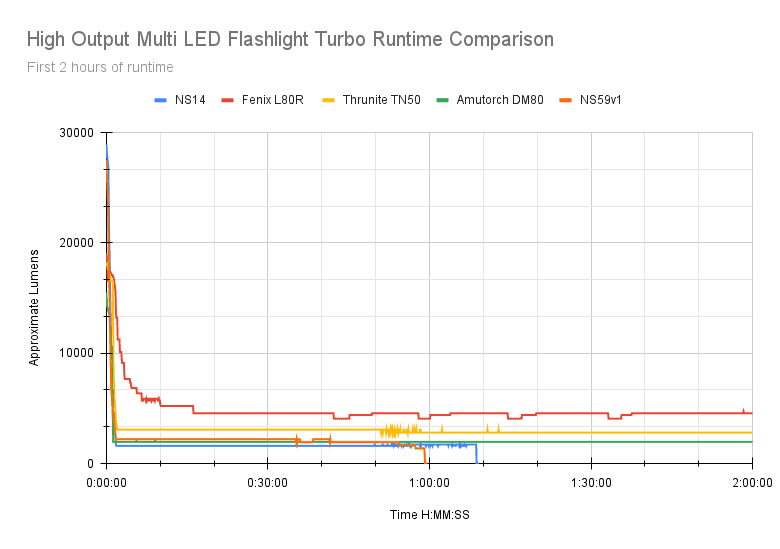
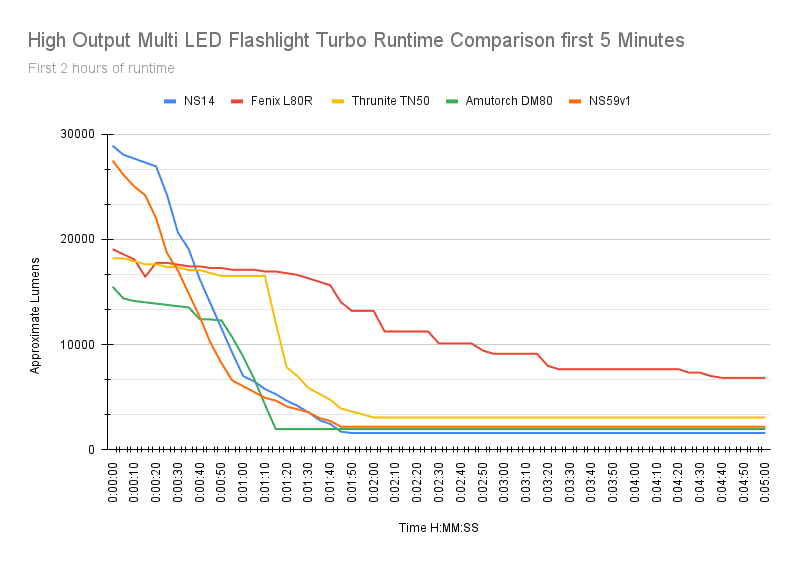
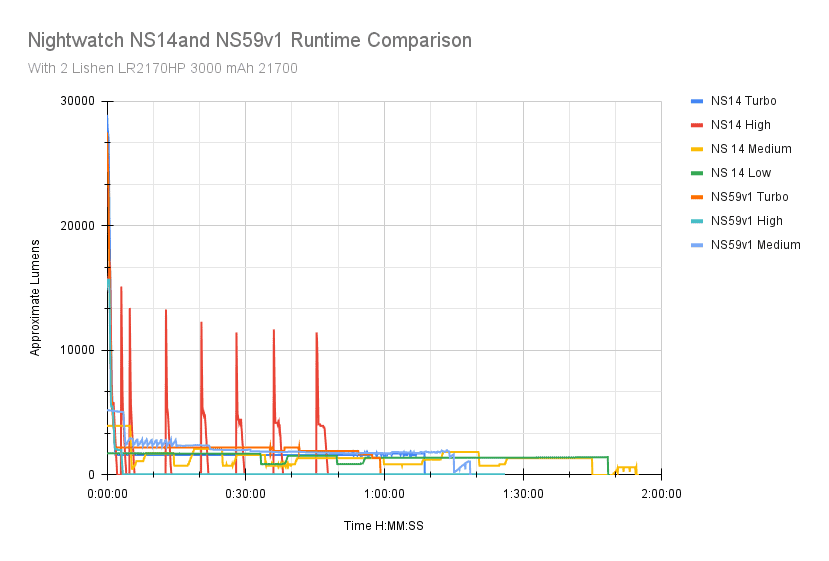
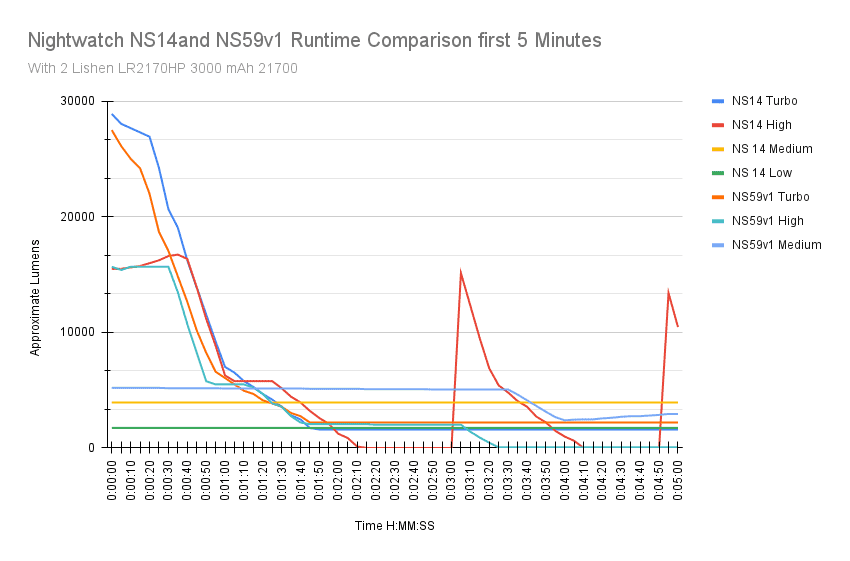
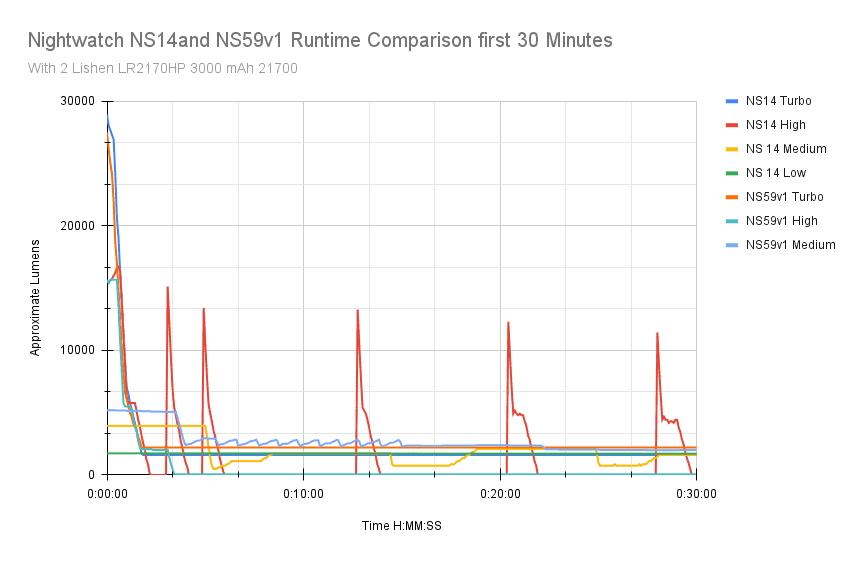
Peak beam intensity and beam distance measurements
About Peak beam intensity: Understanding ANSI FL1 Standards About peak beam intensity The calculated value of distance in meters at which the flashlight produces a light intensity of 0.25 lux. (0.25 lux is about the brightness of a full moon shining on an object). This means that the intensity has decreased so much, it becomes difficult to see darker objects, or objects that don’t reflect light. The columns ‘Meters’ and ‘Yards’ use rounded numbers.Beam distances are measured using a Uni-T UT383S luxmeter measured indoors at 5 meters using the included fully charged Lishen 2170HP batteries. Measurements taken at 30 seconds.
| Mode | Specified | Candela measured | Meters | Yards |
|---|---|---|---|---|
| Moonlight | ? | 1400 | 75 | 82 |
| Low | ? | 5800 | 152 | 166 |
| Medium | ? | 13,550 | 233 | 255 |
| High | ? | 54,100 | 465 | 508 |
| Turbo | 140,000 cd | 63,425 cd | 504 | 551 |
| Turbo at Start | 92,825 cd | 609 | 666 |
The product specs over at Nealsgadgets only lists a candela figure for Turbo mode of 140,000 cd and 748 meters. Once again, I’m coming in a bit down from that by quite a lot, even at start up, and by 30 seconds, the output is dropping rapidly. Still, this is respectable beam distance from a light that wasn’t designed to throw.
Beamshots
I compared the Nightwatch NS14 to some other ultra powerful flashlights. These lights all produce in excess of 14,000 Lumens. Photos taken with my Samsung Note 8. The 95 meter shots with the camera set to 0.3s ISO 200 and 5000K WB.
Beamshots of the following flashlights compared:
- Nighwatch NS59v1
- Nightwatch NI03 Super Valkyrie
- Thrunite TN50
- Wurkkos TS32
- Haikelite HT90
- Haikelite HK90
- Wuben A1
- Amutorch DM80
- Fenix LR80R
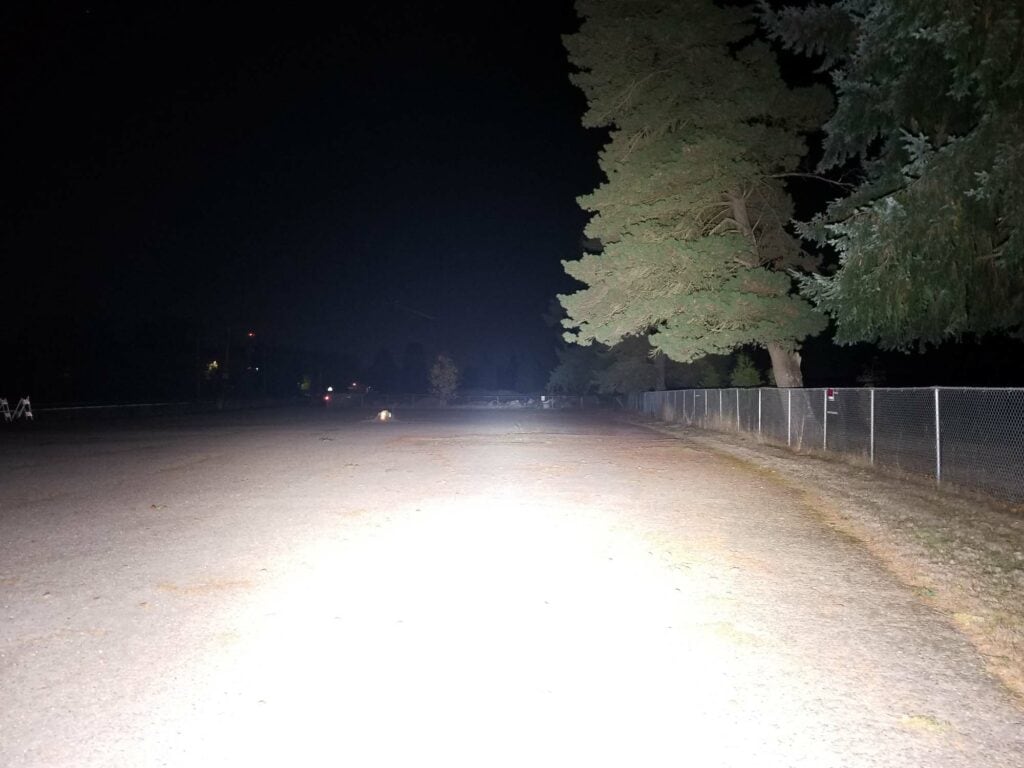
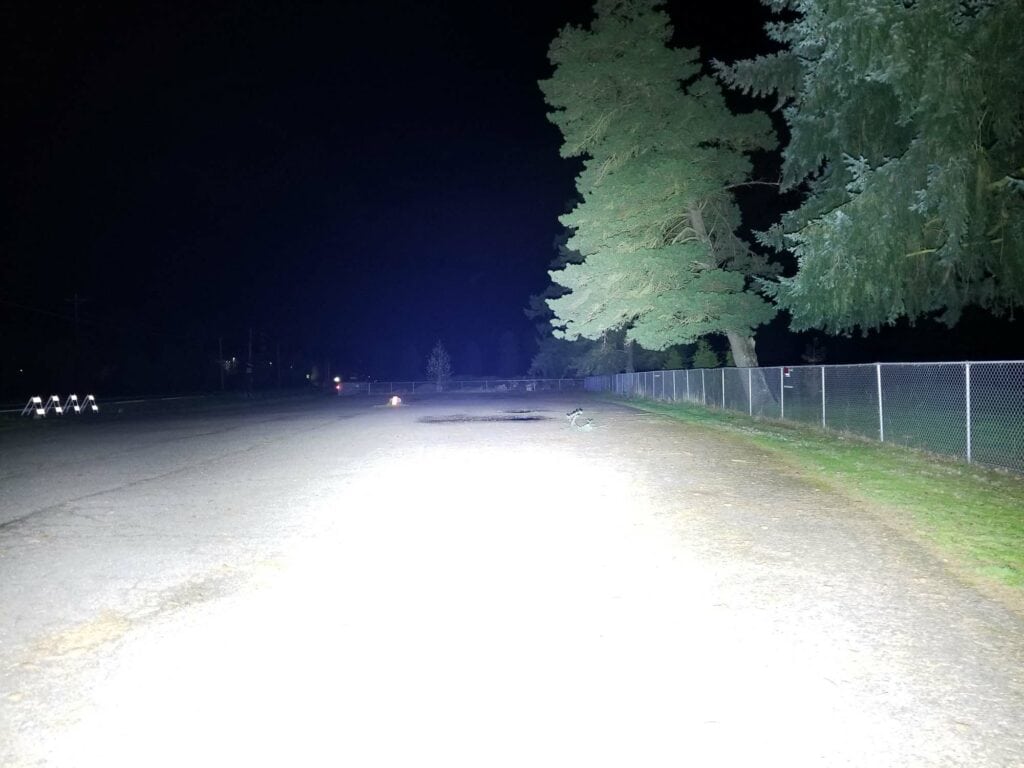

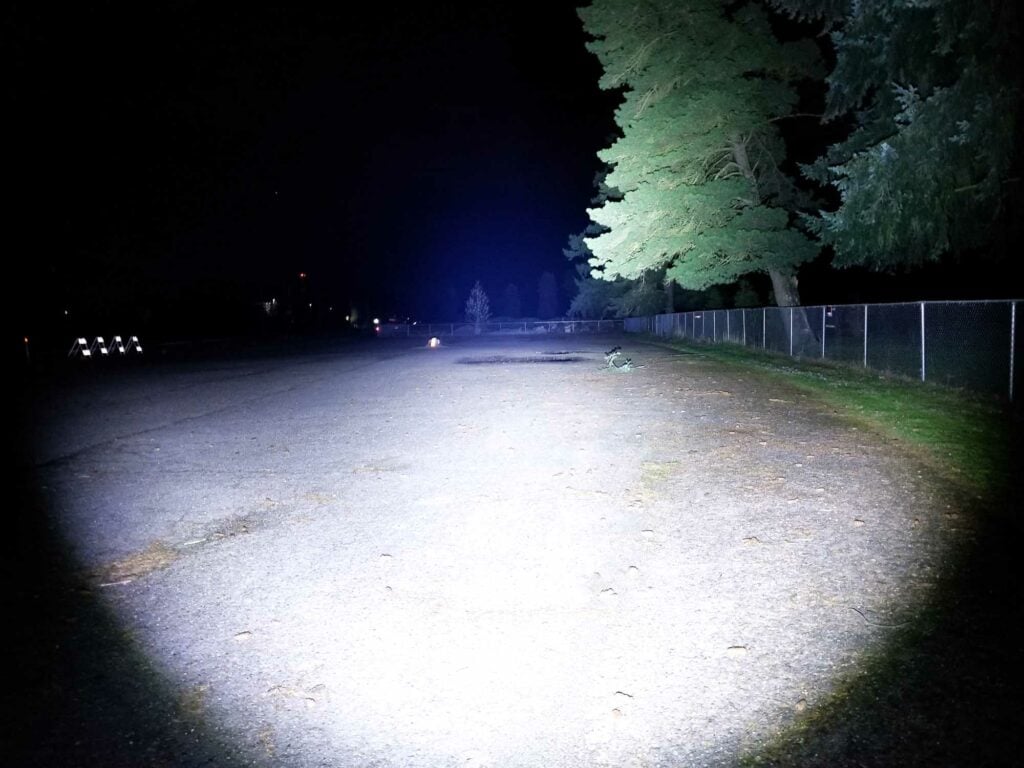

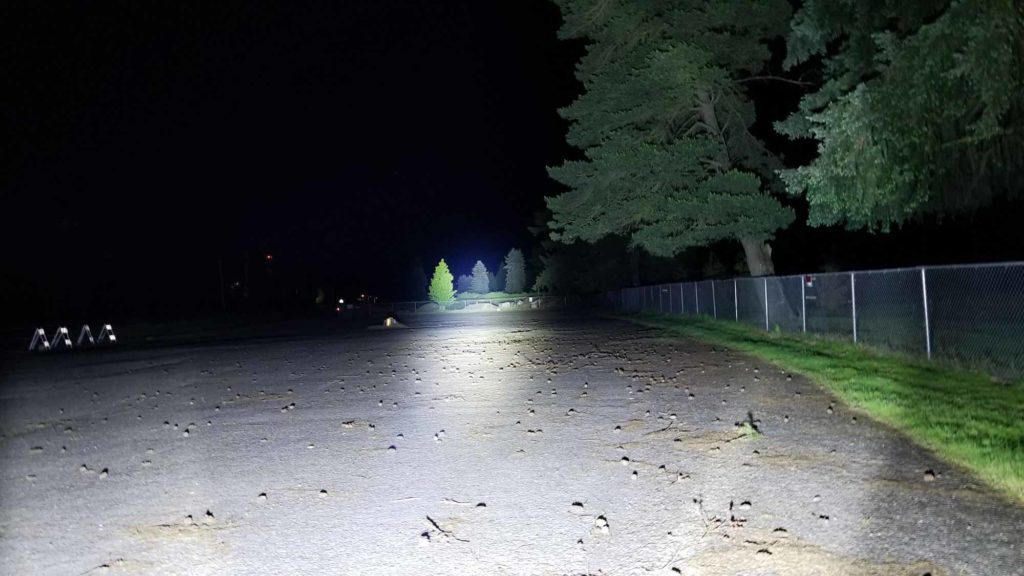
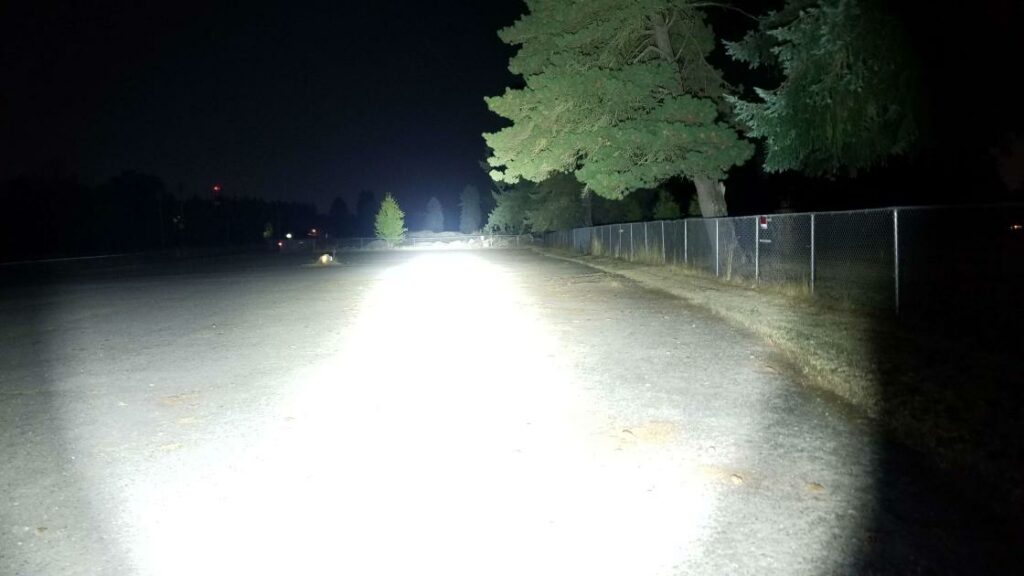
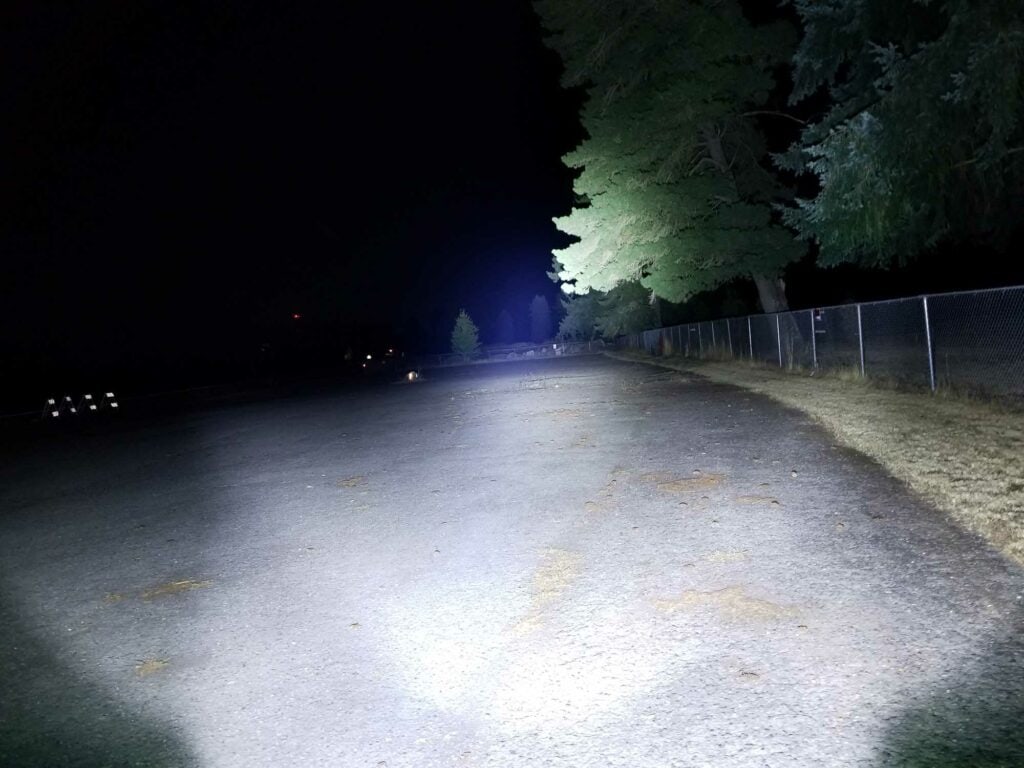
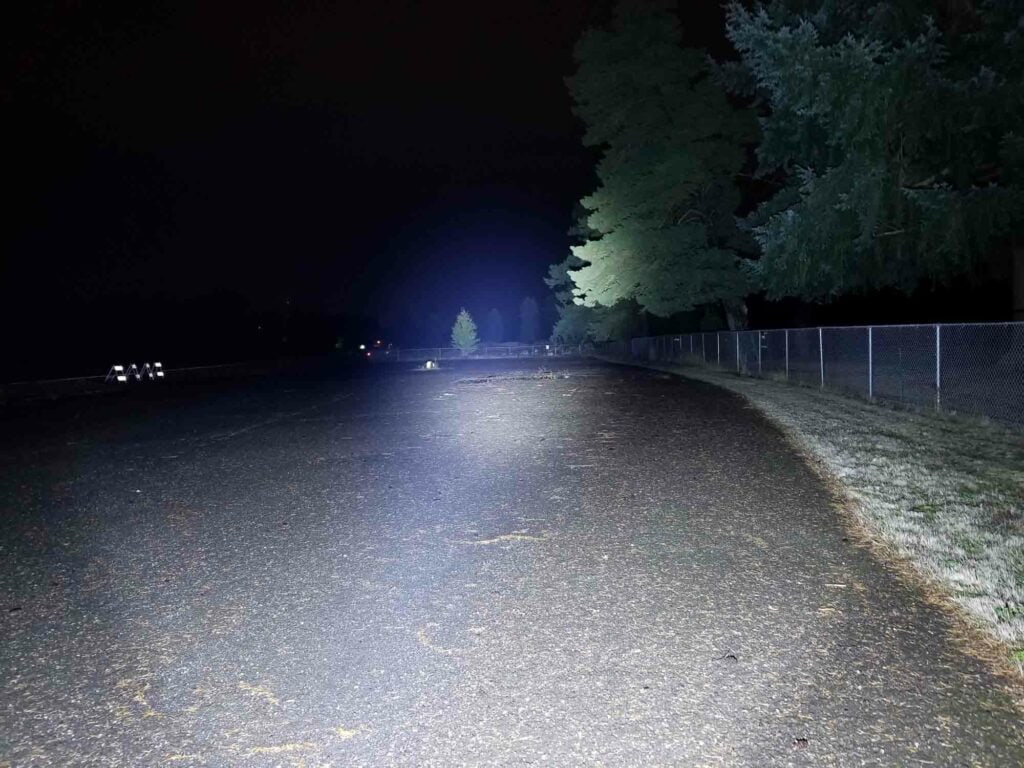
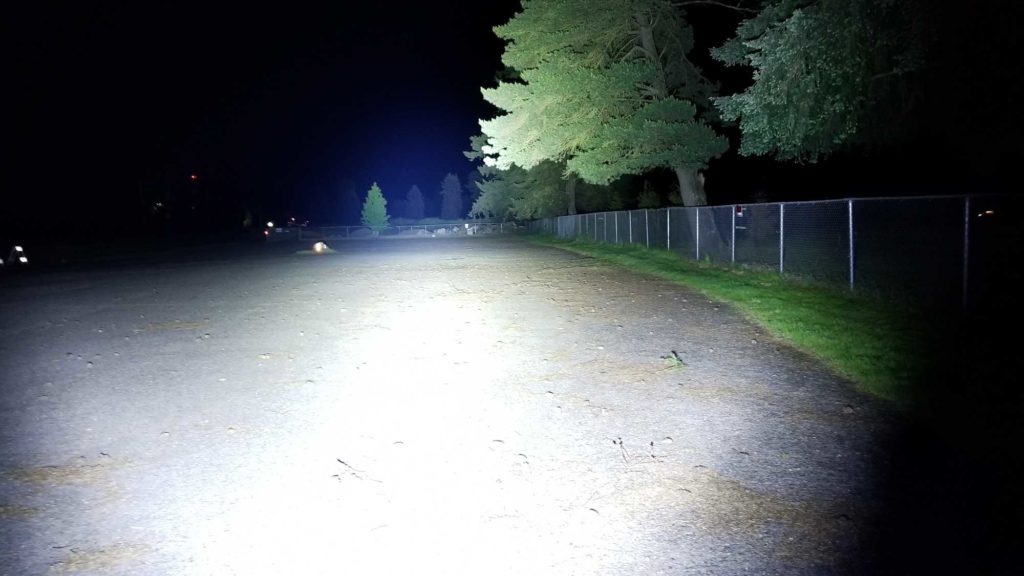
Disclaimer: This flashlight was sent to me for review at no cost by Nealsgadgets. I have not been paid to review, nor have I been holding back on problems or defects.
Final Verdict
Pros
- Decent build quality
- Grippy anodizing
- Simple UI
- Somewhat regulated driver
- Bright with good beam distance
- LVP worked better this time
Cons
- Gets hot fast and stays hot
- Switch is touchy and the UI is unrefined
- Thermal step down algorithm didn’t work properly on my sample
- Requires very high drain button top cells
- High mode doesn’t step down to a lower mode
- Way down on output from factory specs
Explanation on star ratings:
1: Avoid: a match would be a better choice – 2: Poor: significant defect or issues; almost unusable – 3: Average: some defects or issues; but still usable 4: Good: recommended (minor issues) – 5: Great: highly recommended

2.5 stars: ★★⋆
While our star rating provides a reliable indicator, we encourage you to read the full review to make an informed decision based on your own needs and preferences.
As I said in the beginning, Nightwatch lights are a bit of an enigma, often coming with a duplicitous nature. Although I expect concessions to be made in the areas of regulation, runtime, thermal control, and sustained output with these lights, I wasn’t expecting some of what I experienced with this NS14.
That aside, this is a smartly-designed host with a decent thermal path for being so lightweight, and I think Nightwatch did a decent job with that, since it’s basically the same host as the previous NS59v1 (albeit with some design tweaks). This is a very fun flashlight. Clicking into Turbo (when you get it to work), causes instant smiles (and temporary blindness). There’s just something I love about turning pitch black into daylight, something you can only get with a high output, multi LED flashlight like this. For all that firepower, this is a compact flashlight, and is easy to tote around and pretty handy. It was nice to see that Nightwatch addressed the LVP issue as well (as far as I could tell in my limited testing).
Now, there’s some problems, at least with my sample. Foremost is the issue with the High mode step down. Although temperature-limited modes aren’t a new thing, (the Nitecore TM12K has it), it doesn’t work very well here because the light didn’t step down to a lower output…it shut down completely and wouldn’t turn back on. The other modes worked fine though, stepping down to a lower mode for somewhat-decent sustained output, with only the Medium mode exhibiting weird square wave-like thermal regulation. While I expect this type of behavior, I think there’s room for improvement with that. The UI could also be improved to work better with the switch, since the same touchiness I experienced on the NS59 is present in the NS14. All the other issues are pretty much common to small, extreme output lights: They heat up quick, step down the output quick, and have short runtimes. This doesn’t help practicality nor does the fact there’s no onboard charging, and you really need the highest drain cells you can get for this to work.
I was a bit surprised that the output was down so much, since the NS59 pretty much met it’s output spec, but it comes with the territory. Bottom line, the NS14 is not an upgraded NS59v2, and it’s not new. It’s the same NS59v2 with more LEDs, a bit more output, and less practicality. Still, it’s the most Lumens and probably the most fun you can have with a flashlight for around $120.00. 2.5 stars for the NS14, and like the NI03S, there’s some room for improvement here.
Buy your Nightwatch with a discount
Get extra discount with our exclusive Nealsgadgets coupon: 1LumenNew or 1Lumen711
1lumen selects and reviews products personally. We may earn affiliate commissions through our links, which help support our testing.